The rest of the world 1939-45
Summary:
 Albania
Albania
 Austria
Austria
 Belgium
Belgium
 Colombia
Colombia
 Costa Rica
Costa Rica
 Cuba
Cuba
 Czechoslovakia
Czechoslovakia
 Dominican Republic
Dominican Republic
 Haiti
Haiti
 Hungary
Hungary
 Honduras
Honduras
 Estonia
Estonia
 Iceland
Iceland
 Eire
Eire
 Equador
Equador
 Iran
Iran
 Iraq
Iraq
 Latvia
Latvia
 Liberia
Liberia
 Lithuania
Lithuania
 Mandchukuo
Mandchukuo
 Mexico
Mexico
 Morocco
Morocco
 Nicaragua
Nicaragua
 Persia
Persia
 San Salvador
San Salvador
 Sarawak
Sarawak
 Uruguay
Uruguay
 Venezuela
Venezuela
 Zanzibar
Zanzibar
Belligerents of WW2 are well known: The British Empire, Nazi Germany, Italy, France and the low countries (notably Belgium and the Netherlands), the Balkans, Poland, Romania, Hungary, Czechoslovakia, USA, URSS, Japan, Thailand and China. However there were a magnitude of neutral countries as well, which possessed a substantial navy, like Spain or Portugal. For obvious reasons, out of the war, despite Franco’s gesture by sending the Azul Division in Russia. Siam, another less known example, fought Vichy French Indochina on the behalf of Japan in 1941 and so became another belligerent. The second world war was global. Some neutral countries joined the fight late, other were involved even before the war, like Czechoslovakia and Austria. Yes, both had a Navy.
So in this chapter we are about to see the entirety of these forgotten fleets of WW2: Albania, Austria, Belgium, Colombia, Costa Rica, Cuba, Czechoslovakia, Dominican Republic, Ecuador, Eire, Egypt, Estonia, Haiti, Hungary, Honduras, Iraq, Iceland, Latvia, Lithuania, Mexico, Liberia, Mandchuko, Morocco, Nicaragua, Paraguay, Persia (Iran), San Salvador, Sarawak, Uruguay, Venezuela, and Zanzibar…
Definition of a fourth rank Navy in WW2
What is meant by 4th rank are navies from countries with limited budgets around the world, generally able to keep in service light or obsolete cruisers and torpedo boats, gunboats and MTBs, as well as rare submersibles. It was, in essence, a coastal fleet or “green water” fleet, by opposition of a “blue water navy”, capable to project its power over long distances. Third rank fleets fell often also in this category, beyond the Soviet fleet. This categorization still works today.
Most of these nations stayed (wisely) neutral during the Second World War, with some declaring war on the axis towards the end of the conflict. Others were members of the axis (Like Bulgaria), direct or collateral victims of the conflict (Like Albania and the Baltic States). So here are the status of the countries considered :
Albania (neutral), Bulgaria (Axis), Estonia, Lithuania, Lettonia (neutral), Hungary (Axis), Czechoslovakia (Allies), Egypt (British protectorate), Iran/Persia (neutral), Colombia, Mexico, Paraguay, Peru, Venezuela, Uruguay (neutral).
Micro fleets: Beyond any rankings lays a small group of “micro-fleets”, poor states or landlocked ones which had some watery real estate, in the shape of large rivers and lakes. These “navies” actually included only a few ships at best, riverine boats and patrol vessels. Switzerland, for example, had some armed civilian patrol boats on Lake Geneva. They did some anti-smuggling patrols, mostly for populations that transited through the country from occupied Europe, Fascist Italy or Nazi Germany, including many refugees.
The forgotten navies of Europe in detail
Some were soon involved in the war, despite their preventions, others entered it when the situation started to reverse for the axis.
 Albania
Albania
Albania was invaded by Italy in April 1939. Mussolini was driven by the recent example of Germany annexing Austria and Czechoslovakia and the poorest country in Europe seemed an easy picking, with 8,000 soldiers, some Gendarmes and 5 antiquated aircraft. The country also had a Navy: Two minesweepers and four motor boats. Only the later were in service when the war broke out.
The “navy” of the small Kingdom of the Adriatic had distant roots, located north of the Epirots and ancient Molossians, and their distant ancestors were the Illyrian pirates much feared by the Romans. The latter learned to respect them and even copied their agile Lemboi and Actuarias. In 385 BC, Illyria was conquered by Philip II of Macedonia, then by the Romans from 230 BC to 9 BC. Following the fall of Rome, this province became Roman Byzantine under the name of Albanoï. These lands underwent invasions of Goths and other displaced populations until the early Middle Ages. It became part of the kingdom of “Greater Bulgaria”.
Serbia was for a time a vassal state, before the Ottoman empire conquered the whole region. The Albanians then made excellent Janissaries. At the end of the 14th century, Prince Skanderbeg helped by Christian cities reconquered the territory under Turkish domination. After his death however, the country fell again, and for a long time under Ottoman rule. This people over time became strongly Islamized while not preventing local governors from aspiring to more autonomy.
It was not until 1878 when the Pritzen League was formed, that Albania regained independence, and in 1912, following the Balkan war gained it fully. Taken into the torment of the great war, the weak and young state became the playground for successive invaders, the Greeks, Italians, Serbs of Austria-Hungary and Bulgarians. In 1918, these different neighbors had an appetite for the small territory, hoping to gain a slice of it. However the US lobbied for Albania to be independent in 1920, following the Treaty of Tirana.
Seeking Italian protection against its threatening Balkan neighbors, Albania became increasingly dependent of Mussolini’s help, especially until its conservative Muslim leader, Ahmet Zog which took power following a coup d’etat in 1928, becoming King Zog. From then, Albania entered a period of nationalist militarization, this time in defiance of Italy. The Italian reaction would came soon after the declaration of war of September 1939.
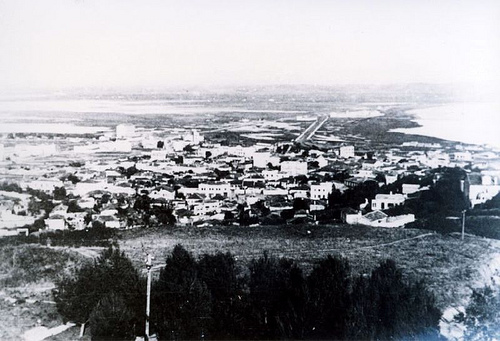
Durrës in Albania (1918).
The Duce saw Albania as weakly defended and on April 7th, 1939, Italian troops entered from the North and progressed rapidly. King Zog fled to Britain. After a week of hopeless fighting, what was left of fighting troops fled to the mountains. The country was officially placed under the crown of Victor Emmanuel III. A pro-fascist Tirana government was established under Shefqet Verlaci, and Albanian troops loyal to the government became part of the Italian army, later taking part in the Greek and Balkan campaigns.
A pro-Communist resistance movement organized in the mountains, and soon coalesced various partisan movements, federated around Enver Hoxha. These made life hard for occupation troops until 1943. At this time as in Yugoslavia, partisan war escaped all control, defeating the Italian army. After the Italian capitulation, the Wehrmacht occupied the country. With the help of the Soviet troops the country was liberated at the end of 1944. Enver Hoxha became in 1945 the leader of Albania, but drifted to personal power and terror until his death in 1988. Albania is still today the poorest European state, barely out of half a century backward isolation, the “north Korea of Europe” which once targeted one blockhaus per inhabitant.
-Skeneberg class minesweepers:
Skeneberg and Squipnia were the ex-FM16 and 26, German ww1 minesweepers. They were 43 x 6 x 1.45 m long (141 x 20 x 5 feets) with two shafts VTE, 600 hp, for 14 knots. They were armed with a single 88 mm gun. Both were discarded in 1935 so no longer in service when the invasion started, however it is not known if they could have been reactivated if mothballed at that time at the Battle of Durrës (1939) but they are not mentioned.
Tiranë class MBs:
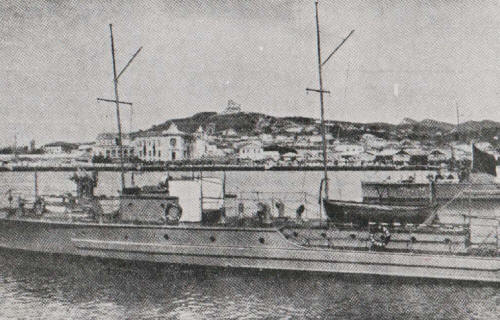
The Tiranë, Saranda, Durres, Vlore were ex-SVAN Venice MS boats built in 1926. They were 46 tons, 80 feets (24.38 m) long 450 bhp boats armed with a single 76 mm (3 in) gun and two MGs. They were in service in April 1939, at Durrës. Indeed the Royal Albanian Navy stationed in Durrës consisted of these four patrol boats and a coastal battery with four 75 mm (3 in) guns, which also took part in the fighting.
Mujo Ulqinaku, the commander of the patrol boat Tiranë, machine-gunned many Italian before he was silenced by an artillery shell from an Italian warship. A large number of light tanks were eventually unloaded and crushed what was left of the remaining forces, gaining full control of the city within five hours, despite the valiant defense of Mujo Ulqinaku. Opposite this, the Regia Marine despatched no less than 2 battleships, 3 heavy cruisers, 3 light cruisers, 9 destroyers and 14 torpedo boats, plus auxiliary and transports.

The Danube, starting in the Alps, crossing Austria and Eastern Europe before ending in the Black sea. This wide waterway was criss-crossed by an intense traffic and served as a natural border.
 Austrian Navy
Austrian Navy
The Anschluss on 12 March 1938 gave the impression it was just a German promenade, a peaceful, stress-less annexation. But Austria was a sovereign state in 1938, with an army, an air force, and a navy, as surprising it might be for a land-lock country. In addition it has a political class divided but in majority hostile to Hitler’s views and attached to the independence, as well as the population. All three armed branches were mobilized. Back in the past, with the disintegration of the Austro-Hungarian Empire, the new Austrian state lost all access to the sea.
This did not prevent it from maintaining riverine patrols on the Danube, making a single flotilla. In 1927, three of these ships were sold to Hungary and one was sold to the Slovakians in 1929. Shortly before 1939, Austria acquired small minelayer crafts and a few modern, also small patrol boats. Before the German annexation in 1938, this only program called for also minesweeping launches. Read More (external)
River Patrol monitors Birago & Fogas (1916)
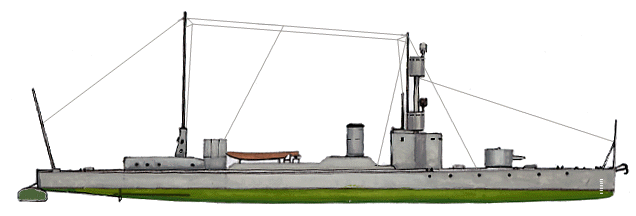
The Czuka, of the same type as the Fogas and Birago.
These Former Austro-Hungarian river armoured gunboats were initially called i and k, built at Budapest in 1915-1916. The same year they took the named of Fogas and Csuka. In 1920, the partition of Austro-Hungarian Navy in the St germain en Laye treaty atributed Fogas to Austria. Her sistership Csuka (former ‘k’) was attributed to Hungary and renamed Siofok. In July 1929 as stated above she was resold to Austria, renamed Birago, but there is nothing clear about possible modifications, other than an overhaul. By default of new infos about it, here are the Fogas and Birago specifications below. In 1927, Fogas was sold back to Hungary and renamed Gödöllö. Birago on her side was the only sizeable armored ship of Austria on the Danube. After the Anschluss she was simply captured and integrated in the German Kriegsmarine as part of the riverine force.
Birago specs
Displacement standard 60 tons
Dimensions: Length 36.0 x 4.60 x 0.90
Machinery: 2 shaft VTE, 2 Yarrow boilers, 800 hp
Max speed 12 kts
Armour: belt: 5mm deck: 4mm turret: 5mm, CT: 5mm
Armament: 66 mm/27 L/30 K.09 gun, two 8.3 mm/66 MGs
Complement: 27
See also: http://www.navypedia.org/ships/austria/austri_rb_fogas.htm – http://www.navypedia.org/ships/austria/austri_rb.htm
The only sizeable ships in the Austrian riverine fleet. 1922, the Hungarian river forces also comprised Szeged, Debrecen and Kecskemet all launched between 1915 and 1918. In 1929, the Siofok, formerly Czuka was overhauled and modernized to be traded to the Austrians in exchange for the patroller Barsch, renamed Baja in Hungarian service. The original Baja has been renamed Hegyalja. The Siofok was renamed Birago in Austrian service (see above).
 Belgium
Belgium
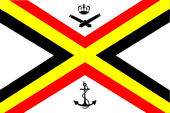 The Belgian navy in WW2 was really tiny, even in comparison to modest third rank fleets of the time. Its Dutch Neighbour for example, outclassed it by a ratio of twenty to one. The trauma of WW1 drove the Belgians into a strong peace movement. Belgium kept her alliance with France, until deciding in 1936 neutrality was the best course of action. Budget spendings were mostly dedicated to the Army and eastern Fortifications, while the Navy was reduced to its barebone role of fishery protection for its modest territorial waters.
The Belgian navy in WW2 was really tiny, even in comparison to modest third rank fleets of the time. Its Dutch Neighbour for example, outclassed it by a ratio of twenty to one. The trauma of WW1 drove the Belgians into a strong peace movement. Belgium kept her alliance with France, until deciding in 1936 neutrality was the best course of action. Budget spendings were mostly dedicated to the Army and eastern Fortifications, while the Navy was reduced to its barebone role of fishery protection for its modest territorial waters.
This would be quite a bad joke for Belgian admirals of the past, as the Flemish Navy in the past was famous. It derived from the proud and mighty Dutch fleet, that of the United Provinces, which managed to rose to the rank of the first European naval power in the XVIIth century. An unparalleled naval power with a global trade empire and first commercial corporation, great rival of the the Royal Navy, which it had beaten several times. The idea of an economic prosperity supported by a vast commercial empire and protected by a fleet in beeing is of Batavian obedience, resumption of the Spanish and Portuguese attempts. Independent since 1830, the small Belgian Monarchy had a few minor high seas units and a few river gunboats for its overseas possessions.
Belgian Navy WW1
In WW1, the Belgian Navy employed a handful of fast government’s cutters, often unarmed for police role. A dozen were available at the beginning of hostilities, rearmed with field guns and machine guns leased by the Army. The very old City of Antwerp (1864) was by then the only specialized fishery guardship. On Lake Tanganyika during the war, Belgium operated the small spare torpedo boat Netta (1915), to patrol boat on Lake Kiru, and the gunboat Paul Renkin (former civilian steamboat) operated in Congo, and the torpedo boat Vankerhoven on the Nile. With the occupation of flanders by the Germans, which created well-protected naval bases, the Belgian government became aware of the usefulness of a small coastal naval forces and developed it from 1919, thanks to peacemeal entente ships acquisitions.
The Belgian Navy in the interwar
The first potent acquisitions were made right after then end of the Hostilities in 1918: The Belgian government took control of no less than 14 German coastal Torpedo Boats after the evacuation of Flanders. These were the A4-A20 (nine 1915 109 tonnes boats) and the larger A30, 40, 42, 43, 47 (1916, 230 tonnes), renumbered A3PC-A9PC and A21PC-A25PC respectively. This coast defence force was administered by the creation of a naval commission, formed in 1919.
On 19 April 1920, this commission purchased its first large vessel, former Flower class corvette, the 1200 tonnes sloop Zinnia (1915). However political change urged budget cuts and the commission was simply disbanded in March 1927. The year prior, all but four TBs were discarded, and the remainder renamed “A” and then given proper names, but in 1928 the Naval Force was disbanded altogether, and the last two TBs, West Diep and Wielingen, were kept for instruction permanently anchored wih a skeleton, civilian reserve crew. The fleet was now reduced to its fishery protection role, taken by the sloop Zinnia, with again, a civilian crew.
The Belgians acquired the 1931 all-sail training vessel (unarmed) Mercator, a 1200 tonnes barquentine, 13.50 Sq feets with auxiliary diesel engine of 500 bhp (11 knots), and crew of 80, used for training civilian recruits. However it was planned in 1938 to replace the old Zinnia by a new sloop which can be used also as royal yacht in peacetime. Since the Belgians lacked the facilities for it, she was partially designed by them as a “jack of all trade”, also training vessel, fishery protection sloop and minelayer/minesweepers with ASW capabilities. However unfortunately for them, the ship ordered at Cockerill in the Netherlands was not yet launched when the Germans invaded the low countries in May 1940. She was seized and launched and completed by them later in 1943 as the Flakship 4 Lorelei (see later).
The Belgian Navy during WW2
Contrary to WWI in which Belgium retained a small part of her territory, the country was completely invaded and occupied, leaving part of the Royal Family in exile in UK for the remainder of the war. King leopold III’s decision in 1936 to withdraw from any allianced and became neutral jeopardized French plans to integrated the belgian territory in case of a german invasion, sparing its own territory and especially the northern industrial areas close to the border. This also mechanically deprived the small Belgian navy from any French or British naval help.
In May 1940, the Germans did not bothered invading Belgium by sea anyway, launching their unstoppable panzerdivisions once the forts fell to a handful of paratroops. After four days, King Leopold III which stayed at the head of its troops, asked for a surrender despite the advice of its government on 28 May, also wildly criticized by the French president, Daladier, for opening a large gash in the allies defences. Soon after, Belgian the coast was occupied and vessels were captured, including in the Netherlands, the Artevelde in construction.
Occupations years were grim. As for WWI the flanders coast fell under German supervision, reactivating two ancient bases to operate Schellbootes. In prison, Leopold remained a focus for resistance, which was organized in UK around the exiled family. From 1942 an increasing number of Belgian men, and even women and children were forced into deportation to munitions factories in Germany, but about 500,000 were saved by the King’s personal pledge to hitler. While resistance was politically divided and very fragmented, this “armée secrete” was nevertheless organized by the exile Pielot Government, participating notably in a repatriation network for downed RAF and USAAF pilots.
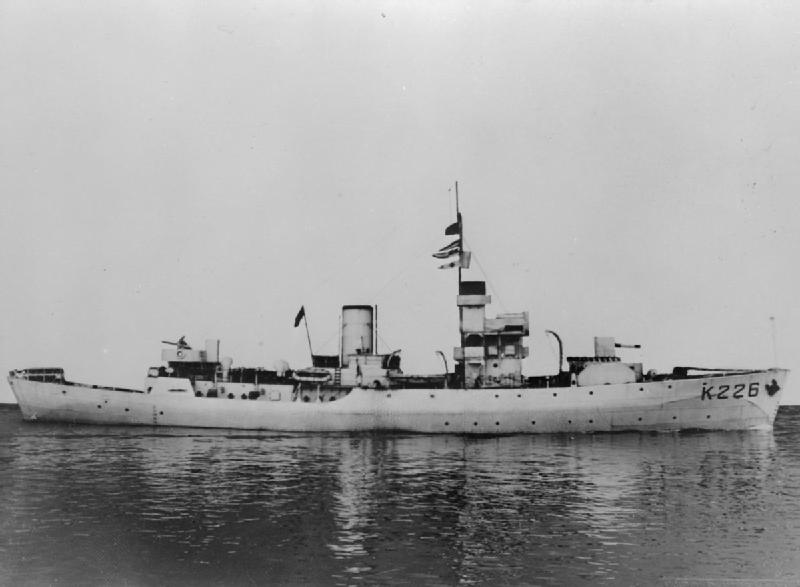
HMS Godetia. Commissioned in February 1942 she was transferred immediately to the Royal Navy Belgian Section, returned to the RN two years later, and was active until October 1945, sold for BU. The Belgians also operated HMS Buttercup (K193), another Fower class corvette, from April 1942 to 1944.
The Free Belgian Forces were established in UK, overwhelmingly centered around the army, as there were few navy personel available. By 1944 the Free Belgian forces in the UK numbered some 4,500 men, which active part (the rest was support) formed the 1st Belgian Infantry Brigade, better known as “brigade piron” after its commander. It operated in the low countries after D-Day, participating in the Normandy Invasion, battles in France and the liberation of the Netherlands. Some took part in elite forces, the 5th SAS unit and No.10 Inter-Allied commandos. Also 400 Belgian pilots served in the RAF, making two entire squadrons. But most importantly, a small “Fre Belgian Navy” was organized around two corvettes and a group of minesweepers operated by the Belgians during the Battle of the Atlantic. By 1943, in total the FBN had 350 enlisted Belgian sailors and officers, under command of the Royal Navy due to its small size.
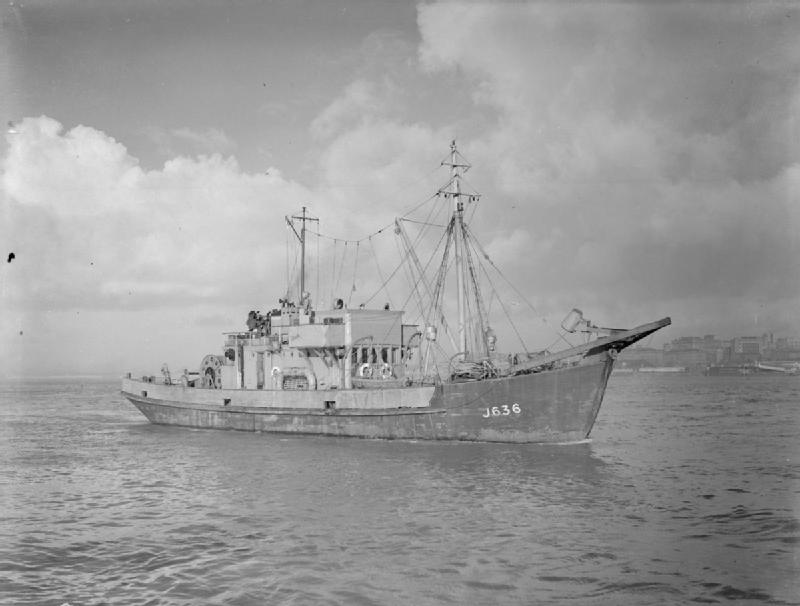
11 British 105-feet Admiralty motor minesweepers (118th minesweeping flotilla) were manned by Belgian crews from the spring 1943. It was dissolved in late 1945 and partly transferred to Belgium in 1946.
 Zinnia (1915)
Zinnia (1915)
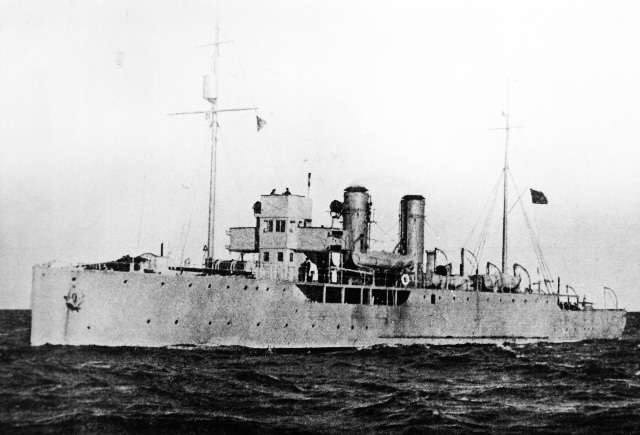
Built at Swan Hunter & Wigham Richardson, Wallsend, this Flower class ASW sloop of 1915 was sold on 19 avril 1920 to the new Torpedo Boats corps sailors of the Belgian Army. 1200 tonnes, capable of a 2 000 miles radius at 15 knots, she was armed with two 101/120 mm guns, two 47 mm AA (6 pdr). She arrived originally totally disarmed. She served from 1920 to 1926 as fishery guard vessel by C.T.M., and became a training ship afterwards, used by the Ostend Navigation School fro training officers.
In May 1940, she was seized by in Bruges and towed to the Hoboken shipyard to be transformed. She became a Flak-Schiffe, rearmed with a single 105 mm turret forward, two twin AA 20 mm gun mounts FLAK 38, plus four single AA of the same so eight in total. She was pressed into served again as KS-4 (Flak ship 4) Barbara in the Kriegsmarine, now based in Swinemünde (Baltic Sea) to defend the artillery school. She was captured by British troops in October 1945 but retroceded to Belgium. She was operated in Ostend by a crew of the RNSB (Royal Navy Section Belge) and later reassigned to the proper Belgian Navy, rearmed. In 1946 she became Breydel and and returned to its fishery patrols in 1947, until withdrawn in 1949, BU the next year.
 Coastal TBs (1916)
Coastal TBs (1916)
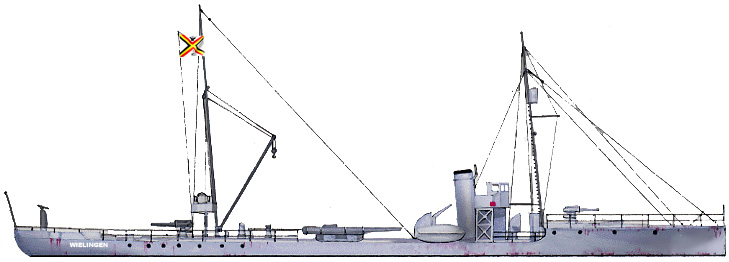
The last six remaining Belgian Coastal Torpedo Boats, which stayed pretty much unaltered during their career: They were armed with two 88/27mm TK L/30 C/08, and a single 450mm TT, plus a mechanical minesweeping gear. They were limited to 25 knots in theory, but no longer in 1940. The A23 PC was sold in 1939, so in 1940 only remained A24 PC (Wielingen). Captured by German troops at Antwerp on 18.5.1940, she was towed to be broken up in 1943 for spare metal. Also the last remaining of the serie I CTBs, A9 PC (“West Diep”) was also captured in Antwerp on 18.5.1940 and this time recommissioned by the Kriegsmarine as KMS Reiher, later Warendorp, for coastal defence and instruction until 1945. She was broken up in 1948.
 Artevelde (1940)
Artevelde (1940)
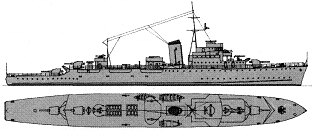
Artevelde in 1945, she was previous called K4 (Flakschiffe Lorelei).
Built in the Netherlands, at Cockerill yard, this Frigate (or sloop for some authors) was originally to be armed as designed by two twin 105 mm guns a twin 40mm AA Bofors, and 30 DCs, plus rails for 64 mines. She was seized by the Germans in the slipway in Antwerp, and later launched on 28.8.1940 as Lorelei and K4. She was towed off to the Netherlands for outfitting, receiving a new German armament: Three single 105/42mm SK C/32, Two single 40/56mm FlaK 28, a twin 37/80mm SK C/30, three quadruple and two twin 20/65mm C/38 FLAK C/38, 120 mines and a mechanical minesweeping gear.
Her original machinery was kept. It was of British origin, Parsons turbine and Babcock & Wilcox boilers working at 32atm, 400°C. She was completed in April 1943 and was recoignised both seaworthy and fast but lacking any protection but for the 40 mm gun shields. They also had poor stability. Until the end of the war, she was used by the Kriegsmarine as an AA escort for convoys. She was later returned to Belgium and returnd into service in 1945 as a frigate (See the cold war section). She was BU in 1954-55.
Note: A cold war Belgian Navy post is in preparation (80% done).
More:
http://www.belgian-navy.be/t1177-zinnia-breydel-garde-peche
http://www.maisondusouvenir.be/corps_de_marine_en_1939_1940.php#_ftn1
http://www.belgian-navy.be/t3889-flakschuschiffe-barabara
https://www.navypedia.org/ships/belgium/be_index.htm
 Hungarian Navy
Hungarian Navy
As a member of the Axis, Hungary was another landlocked country, like Czechoslovakia and Austria, which only waterway was the Danube.
During WW2, the small Hungarian riverine force could only be used to patrol, not really to spearhead anywhere since neighbouring Romania became an ally during the invasion of the summer of 1941 (Operation Barbarossa). However, with the decomposition of the eastern front and offensive of the Red army, Soviet forces soon found themselves invading Hungary itself. Soviet forces had their own riverine forces, and could make them enter the Danube via the black sea, first, after clearing the defenses (notably mines) set up by Romania and Hungary. The Danube could be a vital supply road for Red Army troops in any case, but also carry troops far in advance on rear lines and for diversion operations.
In October-December 1944, fighting on the Danube intensified.
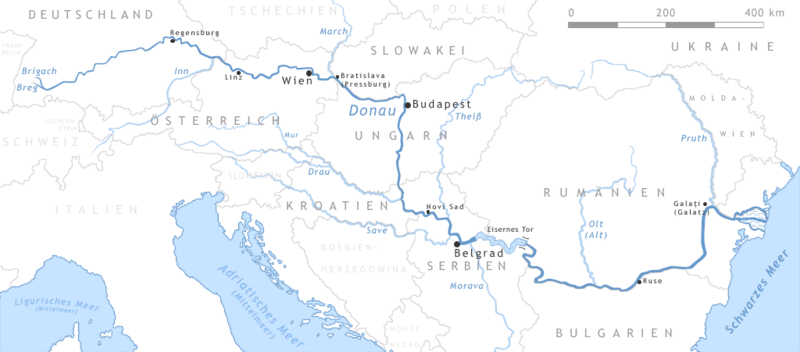
The Danube river, giant waterway of Europe.
Ships of the Hungarian Soviet Republic (1919-22)
After the 1920 partition of St Germain en Laye, Hungary inherited part of the Riverine Austro-Hungarian fleet, which made the bulk of the navy. During the interwar, the oldest ships in service were the LEITHA class river monitors (1872), scrapped in 1921 (or converted as a dredger for the first). They were rebuilt in 1893-1894 but almost did never saw service in the new state of Hungary. They were indeed briefly incorporated in the Hungarian Soviet Republic (see later). The same can be said of the SZAMOS, another armored river monitor (1892). Built in Schoenichen, Újpest, she was also part of this short-lived Hungarian Soviet Republic and converted as a dredger in 1921 (or scrapped, sources are not clear about it);
Another interesting ship that never really integrated the Hungarian Navy in the interwar was the river monitor Inn (1915), a development of the Temes class with one twin turret. She served with the Austro-Hungarian navy but in September 1917 she was sunk on the lower Braila, Danube by a mine. Salvaged and towed off in November, she was repaired in Budapest but work was never completed and she remained there until the end of war. On 21 march 1919 she passed under control of Hungarian Soviet republic, and in April she was renamed Újvidek. In late July 1919 as repairs were completed she was renamed again as Marx and commissioned by the Hungarian Danube flotilla. In November 1919 she was interned by the provisional Government of Yugoslavia at Novi Sad. Under the same treaty seen above she was transferred to Romania, on 15 April 1920 and renamed Basarabia. See the Romanian Navy for details.
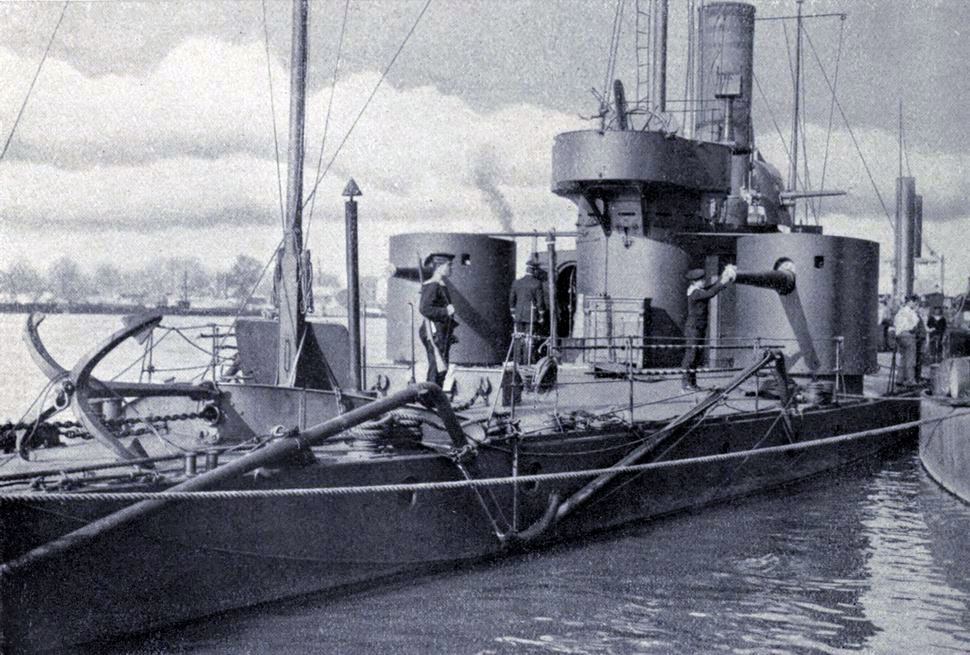
Yugoslav Slava, ex-Bodrog, a good example of the numerous Danube monitors various neighbouring countries used, in particular Hungary.
Ships of the Hungarian Navy (1922-45)
In July 1941 when was lanched Operation Barbarossa, in which Hungary participated with several divisions, the Danube flotilla was also mobilized. At that time the force comprised the four Compo class riverine gunboats, the two Komarom class, the three HÜSZAR class, the Siofok class Gödöllö, and the minelayers KÖRÖS and Maros. The latter was modern-built in 1928. The only wartime constructions has been modern patrol ships of the six PM class, fast shallow-draught armoured motor gunboats built at Hanz Danubius, Budapest. However only one was completed on time to see action against the Red army in the fall of 1944 (See later).
COMPO class armoured river gunboats (1916)
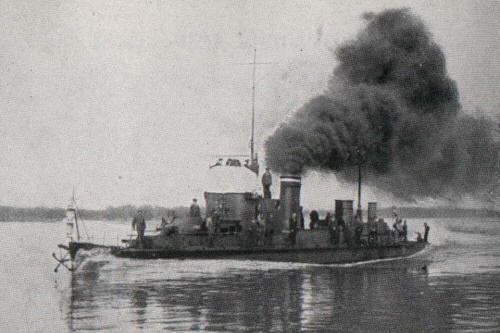
Szeged in 1925
These ships were built at Danubius yard, Budapest, in Austria-Hungary. These were the Szeged (ex-Wels, ex-Bregalnica, ex-Wels, ex-l) launched in 22/10/1915 and completed in 1916. Two after WW1 were given to Yugoslavia and two to Austria but they were eventually purchased by the Hungarian Government after the peace treaties. She was captured by US forces on 8/5/1945 and broken up in 1947-49 like two others. The class also comprised the Baja (ex-Barsch, ex-Neretva, ex-Barsch, ex-m) which was sold as a mercantile barge in the 1940s, the Compo on 10/1927. The third ship was the Györ, retroceded to Austria on 4/1920 as Compo, and purchased again 10/1927, and the fourth was the Viza (Kecskemét, ex-Viza, ex-o).
These amazing ships were the first river gunboats fitted with steam turbines, which was very unusual for riverine vessels, not expected to go fast. But thise served them well; On trials they showed they could reach 17.3-18.5kts and they saw active service in the black sea as well, showing unusually good seaworthiness. Wels and Barsch were interned at Beograd and later passed onto Yugoslavian flag, Bregalnica and Neretva, later passed under Austrian flag and were purchased back by Hungary. They were all captured in Austria by US troops in 1945.
Specifications:
Displacement: 129/133 tonnes
Dmensions: Length/breadth/Draught 44.0 x 6 x 1 m
Machinery: 2 shafts, AEG geared steam turbines, 2 Yarrow boilers, 1200 hp, 15 knots, 18 tons oil
Armour: belt: 8mm, deck: 6mm, turrets: 10mm, CT: 10mm
Armament: 2 x 2 66mm/24 G. L/26 K.15 BAK guns, 2 x 2 – 8.3mm/66 MGs
The Baja had 2 single 75mm/27 G. L/30 K.16 BAG, and 2 x 2 – 8.3mm/83 MGs
Complement: 40
KOMAROM class armoured river gunboat (1918)
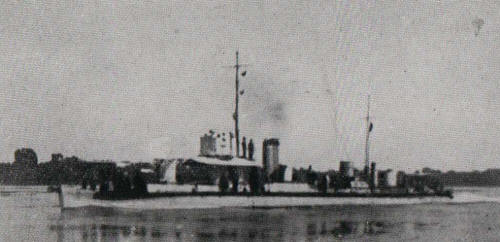
Debrecen 1927
Built at Danubius, Budapest, Austria-Hungary, these former Austro-Hungarian river armoured gunboats were derived from the Wels class and had increased dimensions and modernized AA mounts. Commissioned in August 1918, they were called Stör and Lachs. Allocated to the Hungarian Danube flotilla as Komarom and Pozsony before even the partition was voted. Therefore from 15/4/1920, the first was reallocated to Austria and 14/5/1921. The other was overhauled in 1924 at Debrezen, taking the same name. She was sold on 10/1927 sold to Hungary, modernized and recommissioned as Sopron in 1930. Debrezen was sunk in November 1944 by Soviet tanks at Czepel, near Budapest while Sopron was captured in May 1945 by US troops at Wünsdorf and sold to a private German owner (Hertha, then Irene from 1962), broken up 1966.
Specifications:
Displacement: 129/133 tonnes
Dmensions: Length/breadth/Draughts 44.0 x 6 x 1 m
Machinery: 2 shafts, AEG geared steam turbines, 2 Yarrow boilers, 1200 hp, 15 knots, 18 tons oil
Armour: belt: 8mm, deck: 6mm, turrets: 10mm, CT: 10mm
Armament: 2 x 2 66mm/24 G. L/26 K.15 BAK guns, 2 x 2 – 8.3mm/66 MGs
The Baja had 2 single 75mm/27 G. L/30 K.16 BAG, and 2 x 2 – 8.3mm/83 MGs
Complement: 40
HÜSZAR class armoured river gunboats (1916)
These were three former Russian armour river scout launches, renamed later the Honved, Hüszar and Tüzér in Hungarian service. They had been ordered in 1915 by the War department and never served in the Russian Imperial Navy. They are belonging to two very similar designs and series built by “Vega-Bureau” at Borgo in Finland and the Revensky Factory in Odessa. Captured in 1928 by Austro-Hungarian troops, just three were operational when WW2 broke out, one of the Revensky type and two of the “Vega-Bureau”, based on the Hungarian Danube flotilla.
Specifications:
Displacement 15.2 to 16.0 tons, Breadth 2.75 or 3.05 m draught 0.61-0.70 m
Machinery, 2 shaft Stirling gasoline engines 100 shp
Max speed, 11.5 knots, Armour, belt: 7, deck: 5, turret: 7, CT: 7 mm
Armament: 3 x 1 – 8.3/66 mm.
Complement: 9
SIOFOK class armoured river gunboats (1916)
These former Austro-Hungarian river armoured gunboat built in Budapest in 1915-1916 and renamed Fogas were stransferred to Austria in 1920, and in 1927 sold to Hungary, renamed Gödöllö and Csuka, Siofok. Siofok in 1929 was sold to Austria in exchange for Barsch, renamed Birago and recomissioned by the Kriegsmarine. Gödöllö was in reserve from 1935, reactivated from 1941, sunk by Soviet aircraft at Uipest.
Specifications:
Displacement 60 tonnes, 36 x 4.60 x 0.90 m
2 shafts VTE, 2 Yarrow boilers, 800 hp, 12 knots
Armour 5 mm belt, main deck 4 mm, turret 5 mm, CT 5 mm
Armament: 1 x 66 mm/27 G. L/30 K.09, 2 x 8.3 mm/66 MGs
Complement: 27
PM1 class armoured river gunboats (1940)
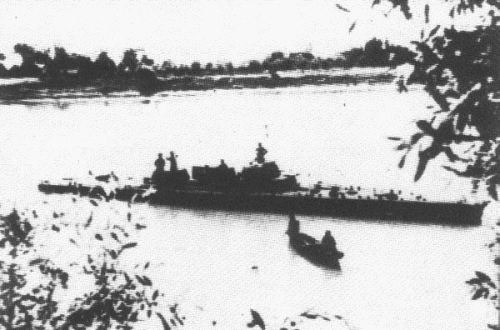
These were wartime fast shallow-draught armoured motor gunboats, made by Hanz Danubius at Budapest. Armed by 40mm/45 in tank gun turrets (From Turán I tanks). They included coaxial 8mm MGs and two more MGs were installed in single mounts inside the deck house, firing through three loophopes. The armoured casemate protected the deck house, the magazines and machinery. They were bad seaboats at high speed, the bow hoping up and masking the view from the low deck house.
This limitation prevent the completion of 5 more boats started in 1942-1943 but still incomplete by late 1944 and later scuttled. The PM3 was commissioned after the war, as PN11 with Soviet armament and partial reconstruction. Others were completed in 1956 as PN31 and PN32, totally modified, and only discarded by 1973. PM1 was badly damaged in November 1944 because of Soviet artillery at Cepel. Surrendered in May 1945 to US Forces and her hull survived s a depot barge at Passau.
Specifications
Displacement 38 tonnes, 28.0 x 3.70 x 0.60-1.10 m
Propulsion 2-3 shaft, 3 Junkers diesels or 2 Lang MP35 diesels 480/420 hp
Top speed 13.5-20.5 knots
Protection: belt: 13, deck: 20, turrets: 40, CT: 40 or 30 mm
Armament: 2x (40/43 Škoda A17 – 83 mm), 2 x 8.3 mm/83 MGs
Or 2 37 mm/73 70K, 1x 82 mm/11 mortar
Complement: 16
KÖRÖS river minelayer (1918)
A single shallow-draught German minesweeper of the FM class. After 1918 she was the mercantile vessel Liselotte, later she was purchased by Hungary in 1928, and rearmed in Budapest, renamed Körös. She was commissioned by the Danube flotilla and became a minelayer and Training ship. She surrendered to US Troops in May 1945 and was discarded an BU in 1949.
Specifications
Displacement 170/193 tonnes FL
41.8 waterline/43.0 m oa x 6.00 x 1.40-1.68 m deeply loaded.
2 shafts VTE, 1 Marine boiler, 600 bhp Top speed 14 knots, 32 tons oil, 650 nm/14 knots
Armament: 2 x 83 mm/66, mines
Complement: 35
MAROS river minelaying boat (1928)
Built at Danubius, Budapest, Maros was the first combat ship built in Hungary after theGreat War, bypassing treaty limitations and classified as and auxiliary netlayer. She displaced 90 tonnes, for 30 x 5 x 0.80 m, one shaft diesel and 280 hp, and was armed with two 83 mm/66 guns, 12 mines or a mechanical minesweeping gear, and carried a crew of 9. Maros surrendered to American troops. After the war she was disarmed and converted as a tug and from 1966 a cruise ship, renamed Hohenau (2005) and then Fanny.
Read More/Src
https://en.wikipedia.org/wiki/Hungary_in_World_War_II
https://www.feldgrau.com/The-Imperial-Austrian-Hungarian-Danube-Flotilla
http://www.navypedia.org/ships/hungary/hu_index.htm
Note: Conway’s volumes made no mentions of the Hungarian riverine fleet, whereas they extend on the Austro-Hungarian Navy.
 Estonian Navy WW2
Estonian Navy WW2
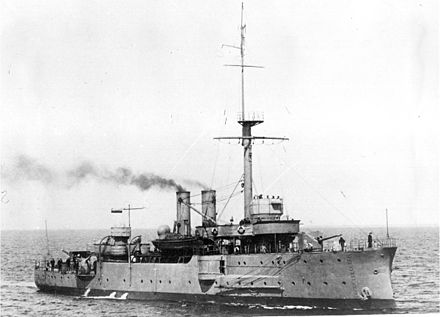
The Estonian gunboat Lembit, in service until 1927.
Although her Navy was created only three years after independence, in 1922, she was balanced and strong for such a small country. Two destroyers, two gunboats, two minelayers were reinforced by auxiliary vessels, while on Lake Peipus three other gunboats guarded from Soviet incursion.
All these ships were of Russian Imperial origin, simply seized in ports in 1918 by the British. Further acquisitions were made in 1920, like a German torpedo boat stranded in Moonsound, towed and repaired. The goal was to maintain a capable green water fleet able to threaten any invading force. In the early 1930s however, amidst economical turmoil, the destroyer Lennuk and Wambola were sold in Peru. Funds saved were used to strengthen maintenance and purchase new submersible and gunboats. The war, however, took place before the construction of additional light ships could be completed.
Documentary: Destroyer Wambola – exhibition 100 years at sea, the ships of Estonia 1918-2018″
Soviet Union officially wishing to strengthen its maritime borders forced Estonia to sign a military assistance on September 28, 1939. Detachments of the Soviet army quickly arrived on the territory, at key defensive points. However, on June 16, the government received a missive, the same as for Latvia, complaining of “provocations” of nationals against the Soviet army and asking for the establishment of a new government to fulfil the commitments of the treaty as well as reinforcement of the troops.
Five days later, with the support of the Soviet army, the Estonian government was deposed and a new pro-Soviet government installed around the Estonian Communist Party. The amalgamation with the USSR was ratified on August 6, 1940, and the navy was dismantled and assimilated to the Soviet fleet.
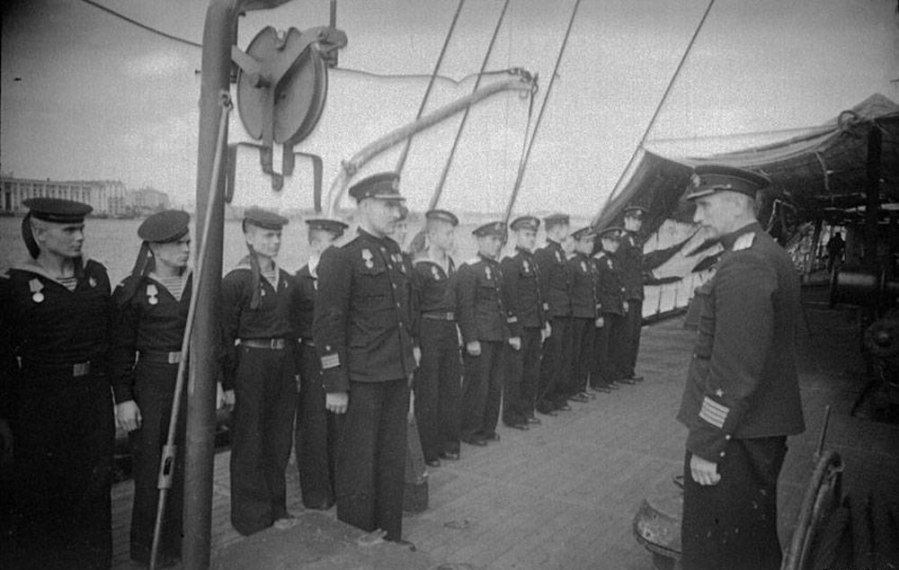
The crew of the submarine Lembit awarded medals for the defense of Leningrad on 6 June 1943.
Ships nomenclature:
Destroyers class Lennuk

A Novik class destroyer
-Lennuk and Wambola, formerly Avtoil and Spartak, of the Novik class, launched 1917. 1,350 tons in displacement, fast and powerful. They were Lettonia’s master ace in area.
Unfortunately they were sold to Peru in 1933. There has been no known change to the ships.Torpedo Boat Sulev
The ex-A32, converted to lay mines. Stranded in October 1917, recovered in 1923 and rebuilt. Taken over by the Soviets in 1939, she was converted into a patrol vessel of the NKVD, then auxiliary and training ship, and finally enede as a pontoon in Leningrad in 1955.
Submersibles class Kalev
Two units ordered at Vickers-Armstrong, launched in 1937. These were coastal, but excellent quality boats. These submersibles, the Kalev and Lembit weighed 620 tons/850 tons underwater, for 58 x 7.30 x 3.30m, powered by two Vickers diesel engiens and two electric motors for 1200/790 hp and 13.5/8.5 knots, for a crew of 58 men.
Captured in 1940 by the Soviets, the Kalev would be used against the Finns (sunk by mines in Hangö in Nov. 1941) while the Lembit became the U1 in 1945, then S85 in 1949, and in 1956 was transferred to a shipyard for experiments. Finally she became a memorial in Tallin, back to Estonia.
gunboat Pikkeri
This modern vessel was built locally in Tallinn, and served as a presidential yacht. In 1940 she passed under Soviet control, as a staff vessel, a sloop in 1941 renamed Kiev, and Luga in 1942, finally Rion from 1946 to 1955, turned into a supply ship. She then began a second civilian life as the research oceanographic ship of Moscow University, taking her old name and operating in the Black Sea until the late 1960s.
Other Ships
The oldest were the Lembit (1st of the name), reformed in 1925, the Wool (ex-Sputnik) sank in September 1941, Wanemune (scuttled in 1941), the minelayer Ristna (demolished in 1960) and Suurop (same class ) sunk in August 1941. More recent were the 200-ton gunboats Mardus, Taara, Uku, Tartu, Ahti, Ilmatar (three served on Lake Peipus), the 50-ton Kalev, Olev and Tahkona mine masters, 8 class stars MP (MP5, 8, 10, 14, 23, Sakala, Delta, Erilane), the three icebreakers Suur Töll, Tasuja, and Juri Vilms, two auxiliary vessels of 200 tonnes, 4 tugboats, and the old Coast Guard Kou (replaced in 1939 by the Pikkeri).
(Work in Progress)
 Iceland Navy WW2
Iceland Navy WW2
Converted merchant vessels were armed to serve as fishery protection vessels. This was setup in 1930:
-Esja (1939, 1347 GRT)
-Aegir (1929, 497 GRT,1x 57 mm gun)
-Thor (1922, 226 GRT ex-purchased German Senator Schafer, 1x 57 mm gun)
-MFV Odinn (1938, 72 tons, 1x 47 mm gun)
-Sudin (1895, 811 GRT, ex-Gotha).
Iceland was independent and neutral at the start of WW2. There was already a fear that operations in Norway would include a Kiesgmarine attempt to invade and use the country as a support base. The allies soon understood the value of the island if it fall into axis hands, notably to disrupt traffic in the north atlantic route. The British government imposed strict export control, notably shipments to Germany as part of its naval blockade.
Winston Churchill offered assistance to Iceland, a cooperation as ‘belligerent and an ally’, but Reykjavik declined. German diplomatic presence remained in Iceland, and after failing to attract Reykjavik as a co-belligerent decision was made of a pre-emprive invasion. On 10 May 194, operations for a landing commenced. 746 British Royal Marines (Colonel Robert Sturges) landed from a ship escorted by destroyers, and on 17 May two regular army brigades arrived. To the invasion followed the occupation. Icelanic naval forces were at no point in measure to counter the British and there was no professional army to speak of.
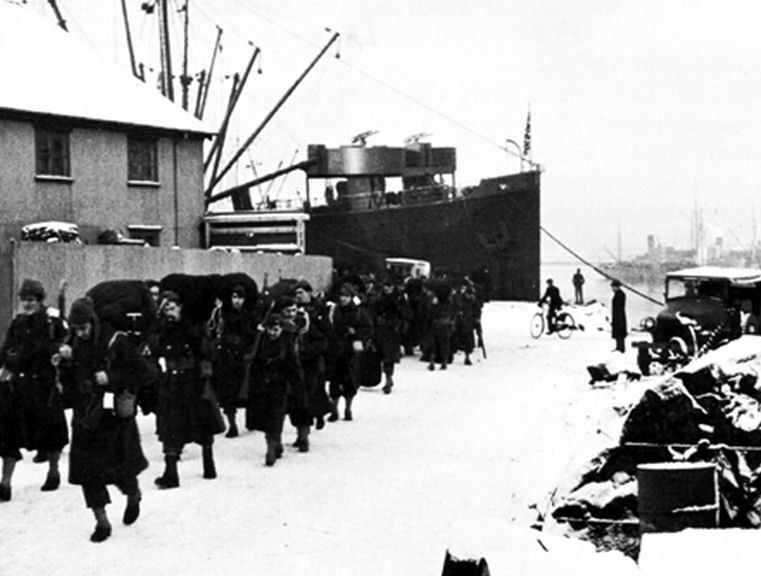
US Troops arrived in Reykjavik in January 1942
In June 1940, “Z” Force arrived from Canada and three Canadian battalions were garrisoned until retired in the spring of 1941, while British reserve garrison forces replaced them in turn. On 7 July 1941, the neutral United States by agreement with Iceland took over the peaceful occupation, with the 1st Provisional Marine Brigade replacing British troops. The 1st Marine Brigade comprised 4,100 troops and garrisoned Iceland until early 1942, replaced by U.S. Army troops, as they were sent to the Pacific.
Iceland cooperated with the allies but maintained a strict neutrality. The “shelter theory” was accepted in order to avoid the greatest threat of a German invasion. Bases for u-Boats and Fw-200 patrol/recce long range bombers could have create havoc on the North Atlantic. Meanwhile warships were stationed there, or passed by, whereas the meagre Iceland fleet kept en eye on Icelandic water sovereignty and protection of fisheries. There were possible reports about U-Boats but no offensive action is known from the Icelandic “Navy” during this conflict.
 Eire
Eire
The young Republic had a small force only fitted for coast guard and fishery protection. These were the :
-Muircha: Ex-Helga 1908 323 GRT converted gunboat
-Fort Rannoch: 1936, 258 GRT gunboat.
-M1 class MTBs (Thornycroft-built 1939): Five 32 tons MTBs, with 4-shaft petrol engines, 2600 hp and 40 knots, armed with two 21-in TTs and two MGs.
 Latvia
Latvia
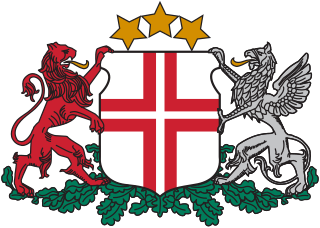 The Latvian Naval Forces were founded on 10 August 1919 with the country taking its independence from the Russian Empire on 18 November 1918 (only recoignised in 1921). Its first ship was the former German minesweeper SMS M68. M68 had been previously sunk by a mine off Riga on October 29 1917 bu she was raised in 1918 and repaired in Riga, later seized by the Latvian Socialist Soviet Republic in 1919, recaptured by Germany and after Independence, formally commissioned as Virsaiti, remaining its only warship until 1926.
The Latvian Naval Forces were founded on 10 August 1919 with the country taking its independence from the Russian Empire on 18 November 1918 (only recoignised in 1921). Its first ship was the former German minesweeper SMS M68. M68 had been previously sunk by a mine off Riga on October 29 1917 bu she was raised in 1918 and repaired in Riga, later seized by the Latvian Socialist Soviet Republic in 1919, recaptured by Germany and after Independence, formally commissioned as Virsaiti, remaining its only warship until 1926.
The same year, the Latvian Navy made the acquisition of two Viesturs-class minesweepers (Viesturs and Imanta) ordered from France, commissioned the same year as two Ronis-class submarines (Ronis and Spīdola) also ordered from France in the same contract. The sixth vacqusition was the ex-German icebreaker Passat, transformed as the submarine tender Varonis.
Post-1929 and the Great Depression hindered any further expansion and reduced training.
The entire fleet under Soviet flag
In August 1940, USSR invaded and occupied Latvia, seized all six warships forcibly incorporated into the Baltic Fleet with the submarines retaining their names, Virsaitis renamed T-297 and Viesturs T-298, Imanta T-299, Varonis renamed “Ural”. They served in in various roles. Ronis and Spīdola were eventually scuttled in Liepāja, June 24 1941 to prevent capture by the advancing wehrmacht wheeras T-299 sank after hitting a mine off Saaremaa by July 1 1941 and Ural on 28 August 1941. Virsaitis evacuated the Soviet garrison on the Hanko Peninsula by late 1941 and on December 2 1941 she took fell to a mine off Hanko. T-298 did survives the war and became a survey ship in 1948. She was not returned to a new Soviet-deminated Latvia.
Virsaitis
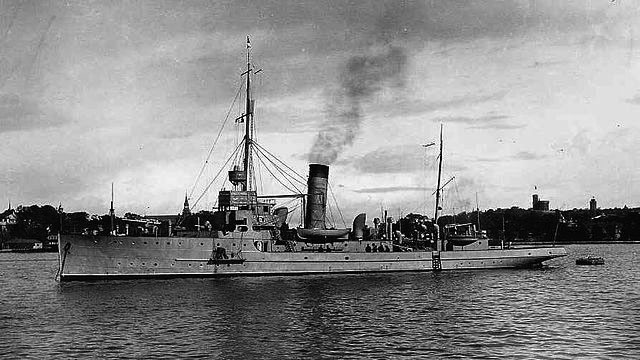
M38 was built in Rostock at AG Neptun, launched in july 1917 as one of the numerous standard M class minesweepers. M68 joined the 3rd Minesweeping half-flotilla, 2nd Minesweeping Flotilla East Baltic and she sunk after striking a mine off Riga, 29 October 1917.
In 1918, M68 she was raised, taken to Riga for repair and by January 1919 seized by the forces of the Latvian Socialist Soviet Republic in the war of Independence, but lost ot the Germans Freikorps in May 1919, when Riga fell. By Riga was passed onto the Latvian Provisional Government and was repaired, after which she was commissioned as Virsaitis on 10 November 1921 and used as guardship for the most basic defensive needs of the country, notably fishery duties and SAR until 1926.
In October 1939, Latvia was pressured into signing a Mutual Assistance Treaty with the Soviet Union. Troops arrived and by June 1940 full occupation of Latvia with forcible incorporation on 3 August 1940 saw the ship incorporated in the Soviet Navy as T-297. She became an escort vessel on 25 July 1941, then called Virsaitis again, to defend Tallinn and shipping to Latvia. From 31 October 1941, she was part of a convoy operations to evacuate the garrison of the Hanko Peninsula, besieged and while in the fourth evacuation convoy on 24 November 1941, and when leaving Hanko on the evening of 2 December she struck a mine and sank.Her wreck was rediscovered in 2011.
Spidola class Submarines
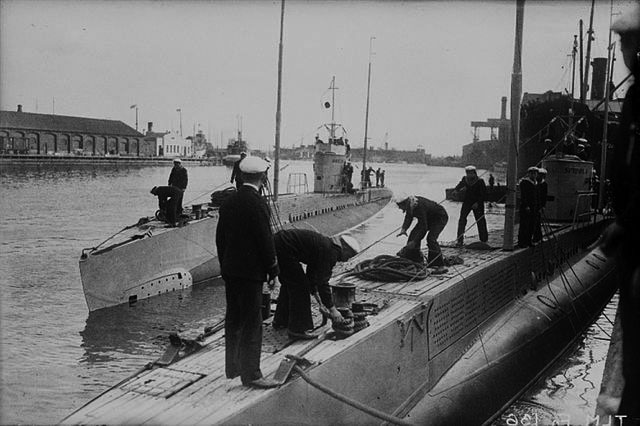
Probably the best assets of the small Latvian Navy, they were part of the largest naval program of the country in the interwar, comprising two modern minesweepers and two submarines to deter any aggression. They were small coastal submarines on a Loire-Simonet 600t design for the Mediterrranean, vut scaled down for local conditions. Ronis means “seal”. They had been ordered to two yards, AC Loire in nantes and AC Normand, Le Havre, ordered in 1925 as part of an expansion adopted by the diet in 1924. Latvia planned to buy two more submarines of higher tonnage but with the crisis of 1929 this fell through. In August 1940 rhey were seized byy USSR under their original names and took part in operations in the Baltic Sea, sent to Liepāja in 1941, scheduled to overhaul in July, but instead they were blow up and scuttled to prevent capture.

Specs:
Displacement: 390 long tons (400 t) surfaced, 514 long tons (522 t) submerged
Dimensions 55 x 4.8 x 3.6m (180 ft 5 in x 15 ft 9 in x 11 ft 10 in)
Propulsion: 2 shafts Sulzer diesels, 1,300 bhp (970 kW), 2 electric motors 700 shp (520 kW)
Surface Speed 14 knots (26 km/h), submerged 9 knots (17 km/h)
Test depth 160 ft (49 m), crew 27
Armed with 6× 21 in (533 mm) TTs (2 bow, twin external launcher) 75 mm (3 in) deck gun, 2× 7.62 mm MGs.
Viesturs class Minesweepers
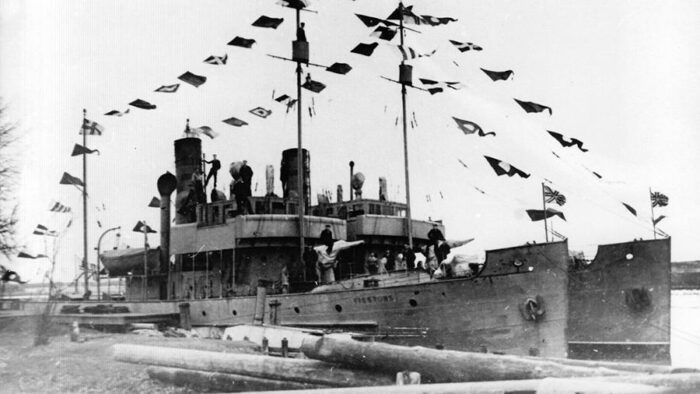
Ordered at the same yard as above, built quicky in 1926, they were purpose-built minesweepers-minelayers developed on a tug design. Single funnel, two masts.
Both were incorporated into the Soviet Navy in August 1940 under new names, lost to mines.
Specs:
265/310t, 48.9 x 6.5 x 1.5m, 2 VTE, 2 Normand boilers 750hp 14kts, coal 28t, 1100 nm/11 kts, 1x 75mm/35 M1925, 30 mines, mechanical minesweeping gear, crew 39.
Sub Tender Varonis
Conway’s All the world’s Fighting Ships 1902-1921 described her as purchased in 1919, former icebreaker German Passat (built 1908), displacement of 250 tons. Ued as sub tender and probably doubling as icebreaker in winter. Took over by the Soviet Union in August 1940, sank in 1941, later salvaged and used by USSR until the 1950s fate unknown. Sources are confusing as in Warships International, vol. 8 1971 she was renamed Pyarnu, BU post WW2. Jane’s Fighting Ships 1944-1945 descrobed her as the Russian depot ship Varonis, 200t dimensions 95½ x 21½ x 12 fee, 425 ihp, 10 knots. Local historian Valdis O. Lumans descriobed her even in “Latvia in World War II” as a French built specialized sub tender from 1908, acquired in 1926. Brassey’s Naval Annual 1941 also called her a former icebreaker turned submarine depot ship and Kafka/Pepperburg 1946 ‘Warships of the World’ also called her a submarine tender and former ice breaker of 1908, sma e specs as above.
The fleet also had the dispatch vessel “Artillerists” (1910, 110, 1930s-8/1940).
Src
https://www.navypedia.org/ships/latvia/lv_index.htm
https://militaryheritagetourism.info/en/military/stories/view/3?0
https://en.wikipedia.org/wiki/Latvian_Naval_Forces
http://warshipsresearch.blogspot.com/2014/07/russian-submarine-depot-ship-varonis.html
 Lithuanian Navy
Lithuanian Navy
The Lithuanian Navy (Lietuvos Karinės jūrų pajėgos) is today the naval arm of the Lithuanian Armed Forces, formally established on 1 August 1935. After the Red Army took over the country, its units were impressed in the Soviet naval forces and fought in World War II. Still, the Navy was re-established since the independence in 1990 and duly modernized.
Unlike the other two Balkan States, Lithuania did not emerge in 1919 with even a small navy, and this factor undoubtedly influenced the future development of Lithuanian naval forces. Another important factor, limiting Lithuania’s interest in the sea, was her very short coastline of only about 22 miles, although in 1924 the Klaipeda region was added to Lithuanian territory as an autonomous province. At this time only a few small motorboats existed for coastal patrol duties. In 1927 the only Lithuanian warship was bought — an ex-German minesweeper; further acquisitions were limited to motorboats for the coast guard service.
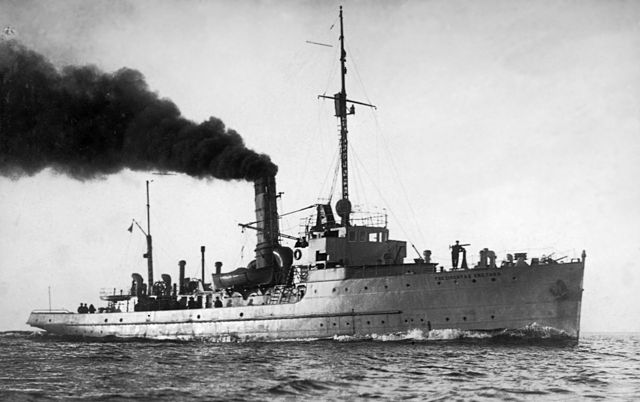
Pdt. Smetonas, ex-German minesweeper, training ship and main asset of the Lithuanian Navy in 1939.
1939 was a significant year for Lithuania. In March the Klaipeda region was seized by the Germans and became part of East Prussia. Six months later a treaty of mutual assistance with the USSR was concluded according to which small detachments of the Soviet Army were stationed in Lithuania. In June 1940 the USSR demanded the creation of new government in Lithuania; after this government was established, it proclaimed the country a Soviet Socialist Republic in July 1940, and on 3.8.40 Lithuania joined the Union of Soviet Socialist Republics. The Lithuanian Navy, small as it was, was taken over by Soviets and incorporated into the Baltic Fleet.
PRESIDENTAS SMETONA patrol vessel (launched 31.10.17)
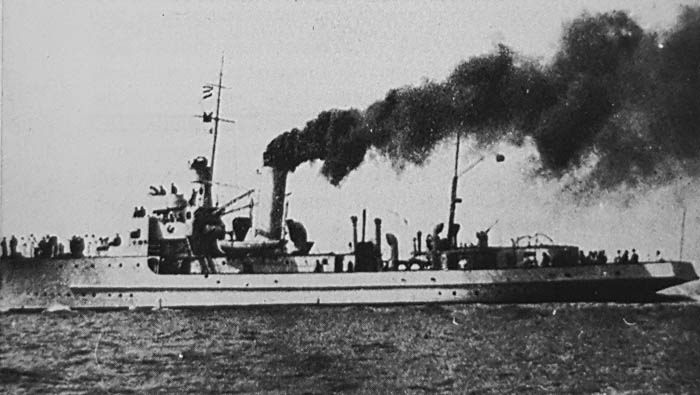
Presidentas Smetona in the late 1930s (Jerzy Micirski Collection)
The former German minesweeper M59, bought in 1927. Under the name Presidentas Smetona she served as a patrol vessel. The name was changed to Antanas Smetona about 1934 and then once again, on 22.6.40, to Primunas. In August 1940 she fell into Soviet hands, was probably renamed Odlichnik, and then became the NK VD guardship Korall. During the war she served as an escort ship. She was sunk in 1944.
Displacement: 500t normal
Dimensions: 183ft 9in wl, 194ft 6in oa, 24ft 3in x 7ft (56.00, 59.30 x 7.40 x 2.15m)
Machinery: 2-shaft TE, 1 Navy boiler, 1850ihp = 16kts. Coal 120t
Armament: 2x 105mm (2x 1)
Complement: 40.
The Lithuanian naval forces also operated 6 motorboats (Attvaras, Saulys, Zaibas , Praschama , Partizanas and Savanoris) and icebreaking tug (Perkunas).
The Middle East
 Persia (Iran) in WW2
Persia (Iran) in WW2
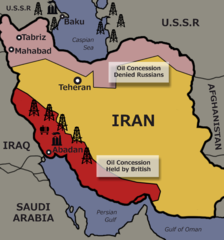 Neutral Iran was another “collateral” victim of the war. The allies feared this wide region potentially strategic at many levels and with petrol could fell into the hands of the axis. This was not an immediate threat though, as at the worst Axis advance of Rommel was at El Alamein, last defendable outpost before the Nile, but after the invasion of USSR, there were fears a part of Herregruppe Sud would divert a panzerdivision beyond the Caucasus and into Iran.
Neutral Iran was another “collateral” victim of the war. The allies feared this wide region potentially strategic at many levels and with petrol could fell into the hands of the axis. This was not an immediate threat though, as at the worst Axis advance of Rommel was at El Alamein, last defendable outpost before the Nile, but after the invasion of USSR, there were fears a part of Herregruppe Sud would divert a panzerdivision beyond the Caucasus and into Iran.
At the start of the hostilities, the Allies asked Iran to remove German nationals on their territory, fearing Nazi spies or a fifth column could act against British oil facilities there (Shell). Reza Shah refused categorically to take any measure. As the war went on, the Allied fear about a German supply from Iran degenerated into questioning the neutrality of Iran. Not only hundreds of “tourists” from Germany regularly visited ports, but German and Italian vessels in transit also stopped there, notably at Bandar Abbas.
Eventually, Reza Shah was given an ultimatum to extrade German workers, refused again.
From there, politicians transmitted the case to the Army. In August 1941, after negociations between the British and Soviet staff ended on plans for a coordinated attack. The British and Soviet troops invaded Iran, in what was called Operation Countenance.
The British arrived from iraq, the Soviet troops from the north, with tanks and aviation. The small Iranian army possessed light Czech tanks and an obsolescent aviation and was in no position to hold back that pincer movement. Quickly brushed aside, combined forces made their junction and marched on Teheran. In September 1941, Reza Shah Pahlavi was forced to abdicate, replaced by his son Mohammad Reza Shah Pahlavi, leaning more towards the Allies.
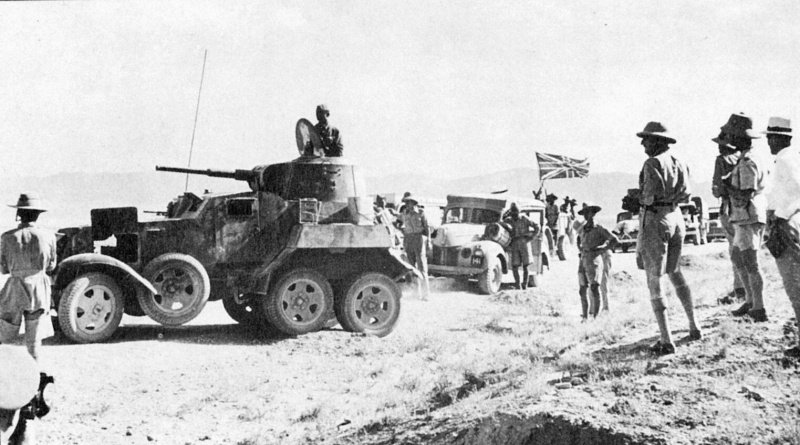
During the invasion, there was little to do for the small Iranian fleet anchored in the Persian Gulf. However, the occupation of the coast enabled the Soviets a new supply road via the port of Bandar Abbas. Soon, a specially constructed railway route was also installed. These were known as the “Persian Corridor”, helping Lend Lease another, les dangerous path than the northern route. Also, Moskow saw this as an opportunity of regional influence. Soviet political operatives soon infiltrated Iran, helping to develop the Tudeh Party in early 1942, affiliated to the Komintern. After the September armistice, Iran entered the Allied sphere of influence and declared war on Germany on 9 September 1943, and on Japan in March 1945.
This did not stopped there as Azerbaijani and Kurdish peoples supported by Moskow rebelled and damaged the new Iranian government action. After the war ended, this went to the creation of the People’s Republic of Azerbaijan (December 1945) and Kurdish People’s Republic, both piloted from Moskow to undermine Iranian regional influence. Soviet troops departed Iran from January 1946, at the expiration of a wartime “protective” treaty which also granted access to American troops. The Navy was soon rebuilt and extended dramatically under conditions of good relations with the new Reza Palhavi government and notably Great Britain.
The Iranian Fleet in WW2
Just before the war in 1939, Iran discarded two old gunvessels, Persepolis (1885, a 1200 tons steamer, also used as Imperial yacht), and Mazaffir (or Muzzafer) (1899, 379 tonnes). The latter was a former Royal Navy gunboat, refitted at Bombay to be resold to Persia. Also were in service the river customs steamer Azerbaidjan (1900s) and Perebonia, and the river gunboat Susa (1885).
-German minesweeper FM24 (1918) was also ordered in 1922. She was renamed Fatiya, Palhavi (1926) and Shahan (1935). Discarded 1945.
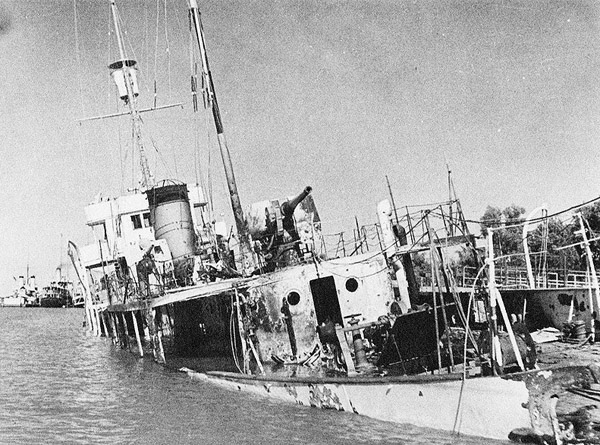
Babr sank at Khorramshar, 25 August 1941
But the bulk of the Persian Navy was eventually reconstructed in the 1930s, with a large naval plans in 1930 and the order of two patrol sloops, four motor patrol boats and six motor launches in 1935. The 1941 invasion has a tremendous impact, with the two sloops sunk and the motor launches scuttled, the other captured. In addition to the vessels listed below, the Royal Yacht Chahsever was also ordered at CNT. She was launched in 1936, a 150 tonnes vessel with precious wood cabins and air conditioned. To serve this fleet, a Tug, Neyrou was also ordered in 1936.
Babr class sloops
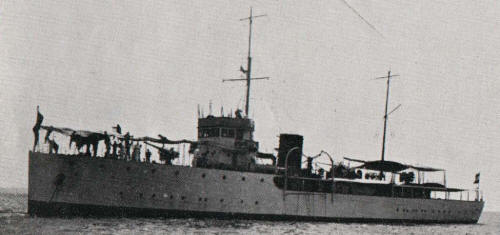
The sloop Babr (1931) – credits naypedia.com
These 950 tonnes vessels were similar to Italian colonial gunboats, with a forecastle and three light guns. They were launched at CNR (Palermo) in September and November 1931. Babr and Palang entered service in 1932, and when the invasion took place, both were sunk on 25 august 1941, on different locations where they were posted: Babr by the British sloop HMS Shoreham at Abadan and Palang at Korrhamshahr by HMAS Yarra. Babr was still recoverable, which was done, but she sank during towing on the Koran river and was lost for good.
Caracteristics:
-950 tonnes, 63.38 m x 9 m x 3 m. Crew 85.
-2 shaft diesels 1900 shp, 15 knots, oil 120 tonnes.
-Armed by three 102 mm guns (4 in) and two MGs (probably Breda). No protection.
Charogh class patrol boats
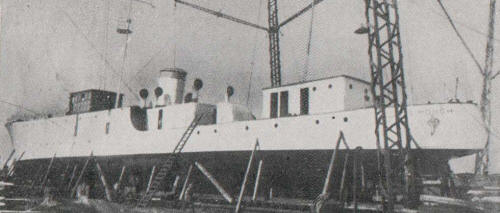
Simurgh in construction in CNT, Palermo, prior to launch (July 1931) credits navypedia.com.
330 tonnes patrol boats from the same Yard (CNT) and ordered at the same time, these vessels were still roomy but of lighter construction than the sloops, narrower (ratio 1/8) and armed with light guns. Four vessels were ordered and delivered: Charogh (or SHAHROKH), Chanbaaz, Karkass, and Simorgh. Despite half the output on Babr, they were faster at 15.5 knots, due to their favourable ratio and lesser draught. They were all captured by commonwealth forces on 25 August 1941. The first two, Charogh and Simorgh by a boarding crew of HMAS Yarra and the others, Chahbaaz and Karkass, by boarding groups from the Indian sloop RIN Lawrence at Bandar-Shapur.
They were sent to the Royal Indian Navy (RIN), renamed Nilam, Hira, Moti, and Lal. They received in Indian service a singe 12-pdr gun and a 20 mm AA. They were used as harbor defence and training vessels in Bombay. They were returned to Iran in 1946 and reverted to their original names.
Caracteristics:
-331 tonnes, 51.80 x 6.7 x 1.83 m, crew 50?
-2 shaft diesel 900 bhp, 15.5 knots
-Armed by two 75 mm and two 37 mm guns AA, all in single mounts.
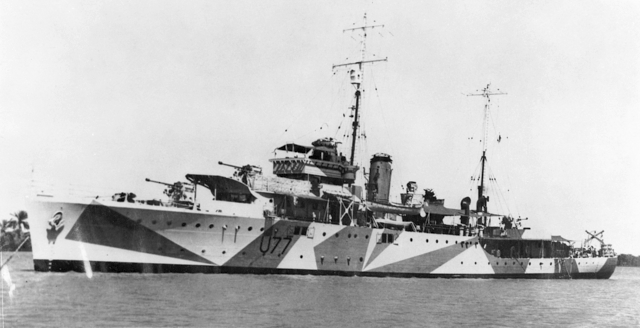
HMAS Yarra, the Australian sloop which sank the INS Palang and captured by boarding parties the patrol ships Charogh and Simorgh.
Azerbaidjan class motor launches
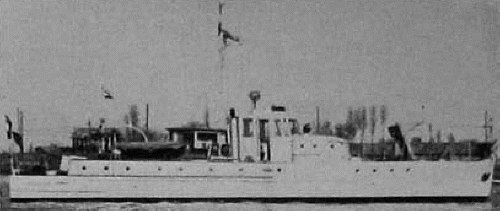
Azerbaidjan clas ship (unidentified) circa 1951 – credits navypedia.com
These six 30 tonnes vessels also ordered to CNR were fitted with Krupp diesels. They were named Azerbaidjan*, Gehlani*, Mazendern*, Babolsan, Gorgan and Sef Indreude and launched in 1935. The first three were scuttled or sunk to avoid captured in August 1941. The fate of the others is unknown, but according to navypedia, they were captured at Bandar-Pehlevi by Soviet troops on 27 August, then pressed into service in September 1941 under new names, SKA-1-3, changed to SKA-200-202, then reverted in 1946 to the Iranian Navy, resuming their service on the Caspian sea until the 1970s.
Caracteristics:
-30 tonnes, 20,88 x 3.81 x 1.07 m, crew 15
-2 shaft Krupp diesels 2×150 bhp, 14 knots
-Armament: one 47mm/40 L/44 (Škoda)
 Iraq in WW2
Iraq in WW2
The Royal Iraqi navy of that era was created in 1937. It was a “microfleet” made of British vessels, under influence of Great Britain.
-Alarm: 1919 Tug HMS St Ewe of the “Saint” class, 820 ton ship, specs same as original.
-Faisal I: Royal yacht, ex-San Pew, ex-Restless, 1923, 1025 tons. At some point she became a lighthouse tender in the 1940s.
-Four Thornycroft-built 1937 patrol boats. 67 tons, 100 x 17 x 3 feets (30.48 x 5.18 x 0.91), 2 shaft diesels 280 bhp, 12 knots, 1x 37 mm howitzer
Fate: Kingdom of Iraq
The Iraqi Navy formed as a riverine police four-ship force was headquartered in Basra. During WW2 it took no part in operations but its polce routine on the Tigris; Until 1958 it stayed at the same level, and was gradually neglected, until the Republican revolution of 1958, and from then largely upgraded (see the cold war section).
Asia
Belligerent Nations were: China, Japan and Siam.
The Chinese Navy was quickly destroyed by the IJN and aviation in 1937 and the following years. It was reduced to nil in WW2. Allied help mostly concerned tanks, planes and ground weaponry. The Imperial Japanese Navy needs no presentation. This formidable force attacked all local powers in the area, after the US Fleet in Hawaii, the IFN fought the Royal Navy and the Dutch Navy, the Australian and New Zealand Navies, going as far as threatening convoys in the Indian Ocean from Madagascar.
An interesting case however is Siam: The Kingdom (future Thailand), independent from the French which colonized nearby Indochina, capitalized on the supposed weakness of Vichy France in 1941, with the blessing of Japan. An attack on French Indochina and a naval battle at Ko Chang however did not bring the expected results. But this is one of these forgotten episodes of WW2. Among small fleets, Mandchuko and Sarawak are worth mentioning.
 Mandchuko in WW2
Mandchuko in WW2
On 18 September 1931 Japane begane to occupy Manchuria and soon gained control of China’s eastern provinces, soon declared an “independent” state in 1932. The country remained under strick and total japanese control, backed by powerful armed forces, strecthed-out by the scale of the territory. Soon, a tailored flotilla of gunboats and patrol craft built in Japan was brought to take control of coastal areas and rivers, mainly the Amur which bordered USSR and its tributaries. This flotilla became independent but only saw real fighting in August 1945 when the Soviet invasion started. However at that stage, records says the Mandhuko flotilla was captured entirely by the combined ground forces and Soviet Amur flotilla. These ships had been incorporated in the Soviet Amur flotilla as a result. Many catpured weapons after the capitulation has been handed over to the Chinese communists, used during the civil war, but the fate of the Amur flotilla is uncertain.
The Mandchuko fleet comprised during WW2:
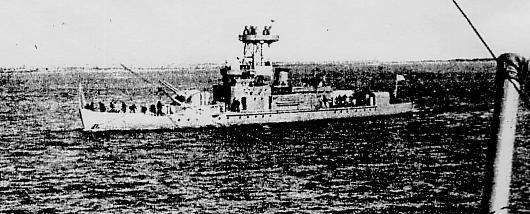
Riverine Gunboat Shun Tien (1935), deployed on the river Amur
–Destroyer Hai Wei, ex Kasii, transferred by the IJN in 1937, returned in 1943.
-Shun Tien class gunboats (270 tonnes, 1934): Shun Tien, Yang Min.
–Ting Pien class gunboats (280 tonnes, 1935). Ting Pien, Chin yen.
All four built in Harima, Japan, shallow draught, heavily armed and well protected. Dimensions 183 and 196 ft or 55.78/59.44 m, 8.884 m long for 0.91 m draught, armed with a twin 120 mm DP forward, single aft, 3 MGs, diesel engines, 680/730 bhp for a top speed of 12.5/13 knots. Complement 70.
–Lisui, ex gunboat Li Chieh, captured 1932.
–Tatung class (YS Tatung, YS Liming, built mistubishi 1933, 65 tonnes, 100 x 16 x 2ft 6 in (30.48 x 4.88 x 0.76 m) diesel engines 240 bhp, 10.5 knots. Armed with a single 57 mm (12 pdr) howitzer, 3 MGs, crew 20.
-About 12 small patrol crafts, and ex-Russian patrol vessels.
Organization
-Mandchuko Naval HQ: Newchwang Naval Base, Fengtien
-Secondary Base: Hulutao Naval Base, Fengtien
Flagship: Destroyer Hai Wei.
-2nd sea Patrol Division (Hai Lung, Hai Feng, Li Sui, Lin Chi)
-3rd sea Patrol Division (Kuan Ning, Kuan Ching, Chian Tung)
-4th sea Patrol Division (Hai Kuang, Hai Jui, Hai Jung, Hai Hua)
-5th sea Patrol Division (Daichii, Kaihen, Kaini, Ta Tung, Li Ming)
Manchukuo Riverine Defense Patrol
Base: Yingkou and Antung, Fengtieng
-1st Patrol Division (Sungari River, Ting Pien, Ching Hen, Shun Tien, Yan Ming, described above)
The Sungari River Flotilla operated armored cars on the frozen rivers during the winter instead for patrols.
For the latter, this unit was called the Manchu Imperial Navy land units. They were formed from Japanese and Manchu crews, operating with the local security naval police, tasked with guarding ports, naval bases and dams. There were two units of 500 men each with light weaponry.
The was also a naval air component. It was called the Manchukuo Imperial Navy Air Force, made of two squadrons of Aichi D1A biplanes. It is not known if there were replaced until 1945.
The Manchukuo Riverine Defense Patrol was formed after the Chinese Songha River Fleet surrendereded to Japan on 15 February 1932. It was made of five river gunboats: Lisui, Liji, Jiangqing, Jiangping, and Jiangtong, later reinforced by four more Japanese-built gunboats, Shuntian, Yangmin, Dingbian, Qinren, Datong, Limin, Xichun, Yangchun, Xingya, and Xingren. In addition eighteen smaller patrol boats were added as well as supply vessels. There was also expeditionary force made of three marine battalions, 2000 men strong in 1940. Officers and most ratings came from the Imperial Japanese Navy.
However in 1939 already, Japan started to withdraw its influence, by February 1939, notably the naval instructors departed. This force was renamed “Jiang Shangjun” (River Army), under a Mandchu captain, Yin Zuoqian as lieutenant general. He was succeeded by Li Wenlong (until September 1942), Xian Yuan (until March 1944) and Cao Bingsen (until August 1945). This unit had to deal from 1932 against Chinese rebels, and guard the border against Soviet incursions and patrol rivers such as the Songha, Heilongjiang (Amur) and Wusuli (Ussuri). Border skirmishes happened like the dispute of the Ganchazi (called by the Russian the Bolshoi island icident) on 19–30 June 1937.
A Soviet gunboat was sunk in action. There was also the Donganzhen incident on 27 May 1939, also with the Soviets, when the Japanese lost one patrol boat, another captured. There was also a clash in WW2, wht skirmish of Xingkai Lake in May 1942: Two Soviet airplanes attacked two Manchukuo patrol boats. In 1942 Japanese sailors were back to the Imperial Japanese Navy. The entire fleet was crewed by Mandchu officers and ratings. On 9 August 1945, four gunboats and three patrol boats mutinied and surrendered and the fleet was captured Soviets after Harbin fell, on 20 August.
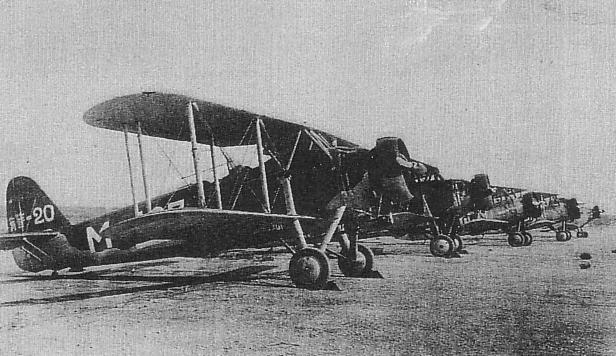
 Sarawak in WW2
Sarawak in WW2
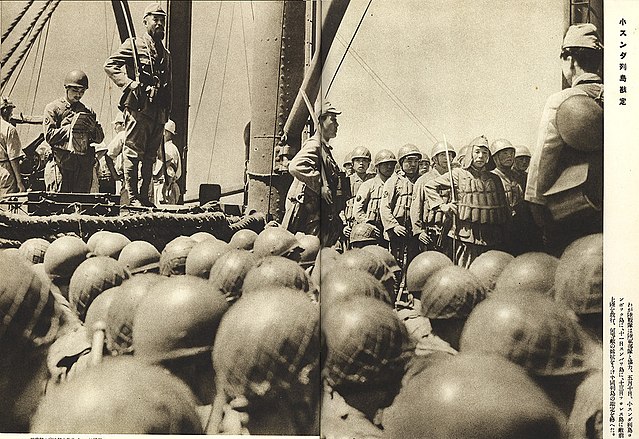
This small British enclave was an oddity in Asia: The Kingdom of Sarawak was created in 1841 by the explorer James Brooke, its first Rajah. After offering military assistance to the Kingdom of Brunei to defeat piracy and insurgency, it became in 1888 a British protectorate, and was annexed in 1890 to the British Empire, along with the Pandaruan region creating the new kingdom’s borders. The Japanese invasion in January 1942 left no chance to the local forces.
At that time, Sarawak was defended by the Indian Army: The 2/15th Punjabi Regiment and a small para-military unit called the Sarawak Rangers. The few anti-aircraft guns which existed were placed on the Kuching Airfield, along with a few obsolete planes. The White Rajah of Sarawak, at that time Charles Vyner Brooke, was in Australia at that time. The naval gun battery comprised two 152 mm (6 in) guns detached from the Hong Kong-Singapore Royal Artillery. It was defended by the 35th Fortress Company of Royal Engineers, at Kuching, about 1,050 men. The Sarawak Rangers comprised about 1,515 men, mainly trained and equipped Iban and Dayak tribesmen.
All units were under command of British Lieutenant Colonel C.M. Lane, named “SARFOR” (Sarawak Force). The oilfields at Miri and Seria and the refinery at Lutong were sabotaged by the British to avoid their fall into Japanese hands. Resistance was futile, and the population suffered from the the occupation. In 1963, Sarawak was incorporated into Malaya, North Borneo, and Singapore, creating the Federation of Malaysia. So apart a land-based Royal Artillery unit there was no real “navy” of Sarawak but possibly one of the ships in service in WW1 (5 gunboats), nominally all discarded in the 1920s.
-Aline (1875, 1 screw gun), Lorna Dorne (1881, 2 small guns), Aden (1884, paddle steamer with 1 small gun), Kaka (1901, 400 grt, paddle steamer), the Yacht Zahora (1894) and a few launches. Alice Lorraine and L’Aubaine were loaned steamers used for transport. On the southern part of the Island, the Dutch had a substantial aviation and two submarines.
South America
 Colombia in WW2
Colombia in WW2
Colombia as a large country still possessing two coastal areas, the Atlantic and Pacific due to it position at the tip of meso-america, and close to the Panama canal, never competed with the three southern giants, Chile, Brazil and Argentina, in part due to its economics. Between 1906 and 1921 indeed its economy was very unstable. By loosing its nortern province of Panama in 1903, political turmoil led to a disregard for the Navy.
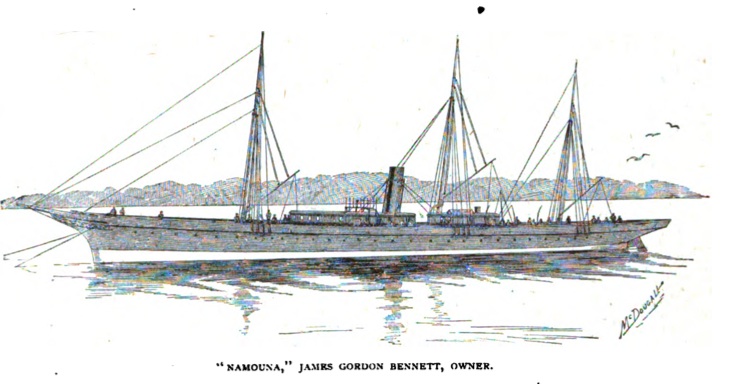
The General Pinzon (ex-Namouna)
The only significant ship until then has been the 1902 Almirante Lezo, a 1200 tonnes “Vickers cruiser” of second hand, previous El Bashir (purchased from Morocco) and later named, Cartagena, and renamed later after her refit in Havana in 1912. The name was an homage to Spanish Admiral Blas de Lezo. She was armed with just two 4.7 in guns (105 mm) and four 1-pounder QF and torpedo tubes above the waterline. She was capable of 15 knots originally but due to neglect she was in poor state, to the point or being stricken in 1925 and latter scrapped.
She took part in an interesting event in 1903: The Panama standoff with the USA.
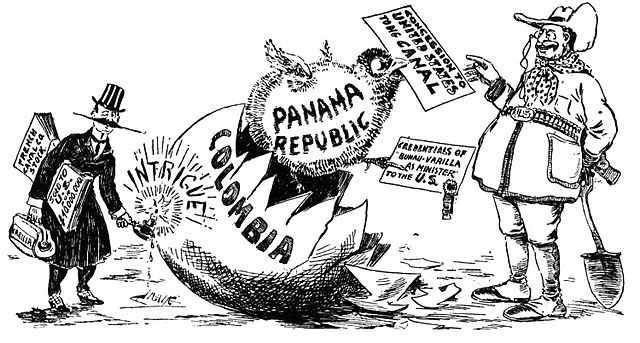
After French effort to build the Panama Canal failed, the United States under “Teddy” Rooselevelt’s lobbying, took up the project due to its strategic value. However at the time, it was part of Colombia. Since the latter proved “uncooperative” it was decided to force ownership of the isthmus by arms. A local rebellion was stirred up and financed, and it drew the attention of the tiny Colombian navy. US ships were sent to watch over the situation, the guboat USS Nashville. It was soon facing its Colombian counterpart, Almirante Lezo. The two ships were comparable, and on paper the Nashville was inferior, but it was just the reverse due to her superior artillery. See US WW1 gunboats. Almirante Lezo was escorting a troop transport to Colon, north of Panama, but the presence of the Nashville made this force withdrawn.
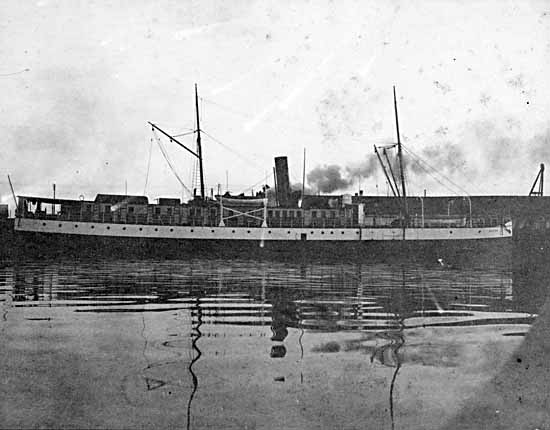
The Gunboat Bogota in 1898
On the Pacific side, Colombia aligned the gunboats Bogota and Padilla, anchored in Panama City. Bogota fired on a rebel shore battery but the US Navy was soon present ion force of this side of Panam as well, and discouraged Colombia from trying harder to stem the rebellion. In the end, the new Ohio-class USS Maine, protected cruiser USS Atlanta joined in, as well as the armed merchant ships Dixie and Prairie in the Atlantic, the monitor USS Wyoming, cruisers USS Boston and Marblehead and gunboat Concord on the Pacific side, with crews already well experienced by their fight against the Spaniards in 1898.
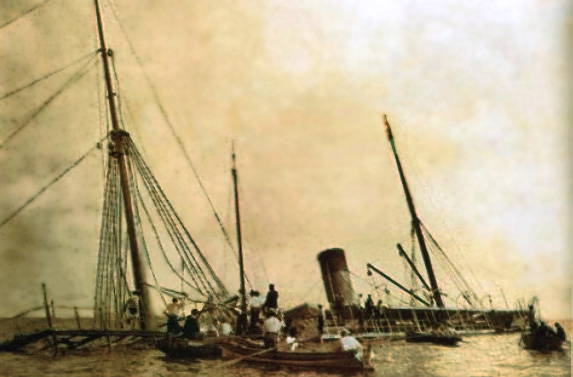
Lautaro sinking in Panama Bay after her action with the rebel Almirante Padilla, 20 January 1902.
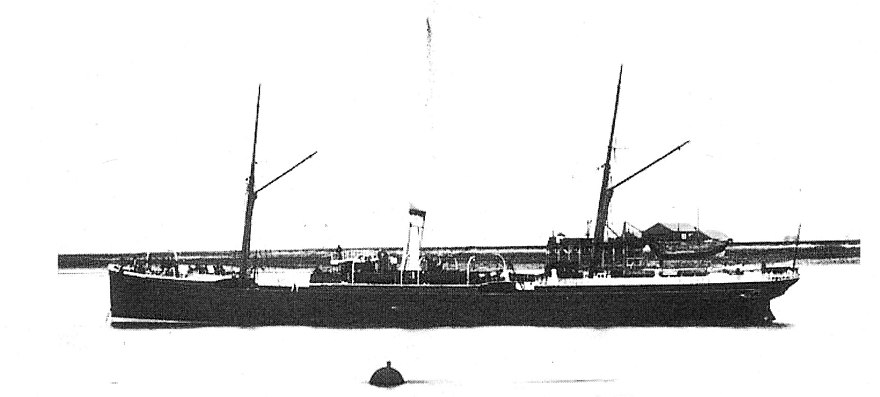
President Marroquin
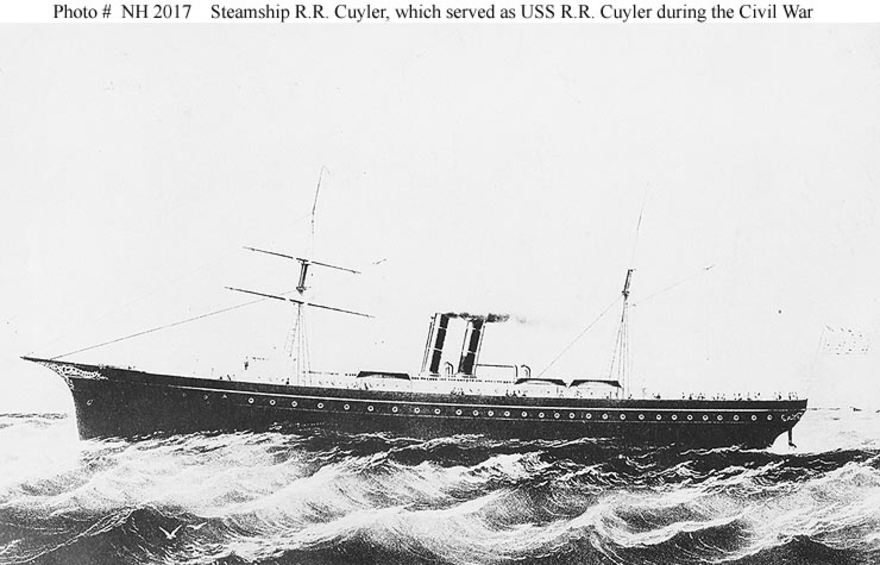
The ex-American civil war steamer RR Cuyler
The same year, in 1903, the Colombians retired the 1870 cruiser General José Maria Córdoba, ex-Neptuno puchased in 1896.
The 1810-founded Colombian Navy still operated during WW1 (in which the country was neutral) the cruiser General Próspero Pinzon a 1881, 740 tonnes cruiser, also of second hand (ex-Namauna) in 1901. She would be discarded in 1916. Another cruiser which changed hands four times, was the President Marroquin (ex-Bolívar). Also built in 1870 in Uk as the civilian steamer Ban Righ, she was bought and lent to Venezuelan rebels, nenamed “Liberatador”, fitted with guns and armor over the engine, steering and bridge. She was returne dto the Colombian Navy in September 1902 and used as training ship until November 1916. In addition we can note here 1888 cruiser 21 de Noviembre (ex-Almirante Padilla) purchased in 1902. A Cargo coaster purchased by rebels by September 1901, heavily, renamed Almirante Padilla, and surrendered in October 1902 to Panama in November 1903.
In addition the Navy had two riverine steam stern wheelers built in New Jersey in 1895-97, with a nickel belt armor and three 1-pdr guns. A third one was larger, 643 tonnes rather than 400, but her characteristics are unknown; All three were discarded in 1935. In 1884 was ordered in the USA, the Steel river gunboat Hércules. She was originally a dredger, converted as an armoured gunboat in 1895-1898 and still active in 1928, sank in an accidental explosion.
Also the Navy operated the steamer La Popa and the transport Cordova. Both were stricken prior to WW1.
In 1913 the only addition was four 20 tones steam launches (by Yarrow) for the coast guard, and only one was armed in 1919, with a local field gun due to British embargo. Eventually the Panama canal issue was fixed between Colombian and the USA in the 1921 treaty.
During the interwar, the Colombian Navy also operated two more modern vessels, the Patrol gunboat Bogotá (Built at Tecklenborg, Geestemunde in Germany, 1919), purchased 1932 as the Former German minesweeper M140. She ran aground and sunk off Isla de Manzanillo in 1936. The Patrol gunboat Córdoba was the Nordseewerke-built (Germany) 1920 minesweeper, M140 sunk in gunnery exercises on 11 June 1937. In 1922 the fleet also operated several Government armed steamers and Government river dredgers (at least four, 1906), listed as of 1922.
The navy reverted to a coastguard and river service until seeing a rapid expansion at the eve of the 1932-33 Peru-Colombia War. The more spectacular acquisition was two ex-Portuguese destroyers, completed by four recent riverine gunboats.
WW2:
In 1939, the Colombian fleet comprised the following:
Vouga class destroyers (1933)

Certainly the most capable ships of the Colombian Navy in 1939, these were the portuguese Douro and Tejo (Vouga class, based on the “A” class or Ambuscade, with a different main artillery) renamed Antioquia and Caldas. Classic 1930 Yarrow destroyer design. Conway’s list the first as the “Antiquois”. Built at Estaleiro Real de Lisboa, Portugal they were both commissioned in Colombian service in 1934, February and April.
Orignally planned for the Portuguese navy, they were purchased on the stocks on 27.3.1933 as an intermediary for British private concern about Peru’s recent acquisition of Novik class destroyers, previous purchased by Estonia. The crews of both Colombian destroyers were hired by the same British company and they arrived in Colombia by May 1934. To be versatile, the destroyers were equipped with rails for minelaying, and had depht-charges. They were original in what they combined Curtiss geared turbine sets and Parsons cruising turbines for economical cruises.
During WW2, they were fitted woth two more 20mm/70 Mk 4 Oerlikon AA guns. In 1952 and 1955 respectively, they received an additional two 127mm/38 Mk 30 guns and six 40mm /60 Bofors Mk 3, plus a 24-barrel (178 rockets) ASWRL Hedgehog Mk 11 and four more modern DCTs as well as a modern radar and sonar. They were discarded in 1961. By then, the Colombian navy has been buffered by numerous acquisitions of larger ships, Swedish and American, rising several fold.
Specifications:
Displacement: 1219 tons standard, 1563 tons FL
Dimensions: 93.6/98.5 (oa) x 9.44 x 2.74
Propulsion: 2 shafts Parsons geared steam turbines, 3 Yarrow boilers, 33,000 shp, 36 kts.
Radius of action: Oil 292 tones, 5400 nm at 15 knots.
Armament: Four 120mm/50 Mk.G, Three 40mm/39 2pdr QF Mk II, 2×4 533 TTs, 20 mines, 2 DCT (12)
Other equipment: Hydrophone
Crew: 147
Colombian gunboats
-Steel river gunboat Presidente Mosquera (ex-Colombia), built in 1912. She was still active as a school for mechanics and boys in 1955, but sunk at moorings 28 November 1957.
-Carabobo class Patrol gunboats (built at C. A. de St. Nazaire-Penhoet, Rouen). Three ships launched launched 1925, and used as Coastguard and later river patrol vessel, Discarded in 1950. Also the Junín (ex-Boyacá) and Pichincha.
-Cartagena class river gunboats: built at Yarrow (Glasgow), comissioned 1931. Also Santa Marta and Barranquilla, stricken 1963, 69 and 85. These were 142 tonnes ships (dimensions 39.62/41.83 m x 7.16 x 0.84 m), powered by two Gardner semi-diesels, 600 bhp and 15.5 knots, armed wth a single 3-in gun (76 mm) and four MGs.
-Patrol gunboat Mariscal Sucre. Yarrow & Co. Glasgow built in 1909, acquired in 1933. This was the former yacht Flying Fox (ex-Winchester) which was used for naval school from 6 December 1948 and stricken in 1955.
Read More:
www.navypedia.org/ships/colombia/col_index.htm
en.wikipedia.org/wiki/List_of_decommissioned_ships_of_the_Colombian_Navy
 Costa Rica in WW2
Costa Rica in WW2
To come…
 Cuba in WW2
Cuba in WW2
The Cuban fleet protected its important territorial waters with a fleet of pre-ww1 gunboats of variable tonnage, which are in detail:
-Cuba: 1911, 2055 tons, retired from service in 1971
-Patria: 1911, 1200 tons, retired in 1955.
-Class Diez de Octubre: Dice de Octubre and Veinte y quarto de Febrero (1911, 208 tons, reformed in 1946)
-Baire: 1906, 500 tons, reformed 1948.
 Dominican Republic
Dominican Republic
The small country possessed a limited sea facade, and operated a few patrol boats on rivers but no major ships. However the great “postwar discount” allowed the South-American country to purchase an ex- British River class frigate in 1946, renamed Presidente Trujillo, as well as an ex-Flower class Corvette called Colon (Or Cristobal Colon), also acquired from Canada. She was active in 1980 whereas Trujillo was renamed Mello and served from 1962 as a presidential yacht. She was still active in 1980 but her current status is unknown.
 Equador
Equador
Apart a riverine force to patrol the amazon, the small Equadorian Navy only existed thanks to the use of nearby Chilean naval infrastructure for training.
Libertudor Bolivar: The only significant sea-going warship in service was the 1896 Libertudor Bolivar, ex-Almirante Simpson, a 750 tons gunboat acquired in 1907 from Chile, still active until 1932 when she was discarded.
Cotopaxi: The only other significant warship in service during the interwar was the 300 tons Cotopaxi, dating back from 1884. She was also discarded in 1932, leaving Equador without any sea-going vessel during WW2.
 Mexico
Mexico
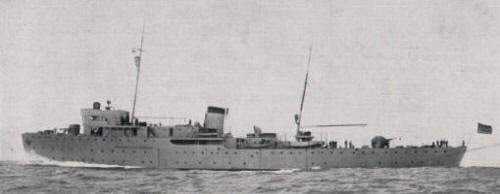
Although one of the wealthiest country in South America, Mexico never invested in a substantial Navy.
In 1918, the Mexican Navy inherited a large collection of ships dating back 1892 to 1903 (the country stayed neutral, rocked by a revolution):
-The old cruiser Zaragosa (1891), discarded in 1924
-Independecia class gunboats (Independencia, Libertad, 1874, 480 tons) discarded in the early 1920s
-The Plan de Guadalupe (1892, 824 tons) stricken in 1924
-The Tampico class gunboats (1902, 980 tons) stricken 1924
-The Nicholas Bravo class (1903, 1227 tons) stricken 1925
During the interwar, it was made of a relatively modern fleet inherited from the 1932 naval plan, and in addition to a large coast defence ship purchased in 1924 to Brazil, the Mexican feet was reinforced by three destroyer-size patrol sloops (Spanish built), two gunboat-transports (also Spanish built), and ten gunboats (Basque-built on British plans). The government chose to support the Spanish Republicans in 1931 and still during the civil war.
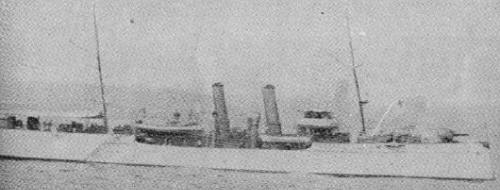
The gunboat Nicholas Bravo
Transport cruiser General Guerrero (1908)
A British-built vessel from Vickers, Barrow this was more a transport than a cruiser with her light armament, and despite having tailored accomodations for 550 troops, 45 horses and field guns, she was still relatively narrow. Her guns were installed on the forecastle (one), the remainder on the poop deck. Also names Vicente Guerrero she commemorated the leader of the war of independence and third Mexican president in 1829. She was stricken in 1924, quite early, for reasons unknown.
Specs:
-1850 tons, 74.6 x 13.2 x 5.3 m
-1 shaft VTE 1500 shp 12 knots
-Armed with 6 x 4-in (102 mm), crew 300
The fleet also operated the coast defence ship Anahuac, purchased in Brazil in 1924, not modernized and discarded in 1938.
Mexico during the interwar:
We will not dwelve in detail in these events, but internal political history of Mexico is perhaps one of the factors which contributed to limit the country’s naval ambitions. The only goal of the navy in these troubled times was to protect the coast, fishery areas, carry and support troops in internal police operations.
The first period was called the Obregón presidency, 1920–1924 a General that suppressed Huerta’s rebellion with US help, followed by Calles presidency, 1924–1928, elected after a popular campaign and it was marked by anticlerical measures and the repression of a fierce counter-revolution called the Cristero War (1926–1929). It was followed by the Maximato and the Formation of the ruling party, and three presidents held office, Emilio Portes Gil, Pascual Ortiz Rubio, and Abelardo L. Rodríguez. This was followed by the revitalization of the revolution under President Lázaro Cárdenas, which at the eve of World War II (1934–1940), its administration was just stabilizing and consolidating control over Mexico. Since 1936, Mexicans interpreted the civil war in Spain as a major struggle between the communists and fascists seen through their unique revolutionary lens.
Mexico during WW2:
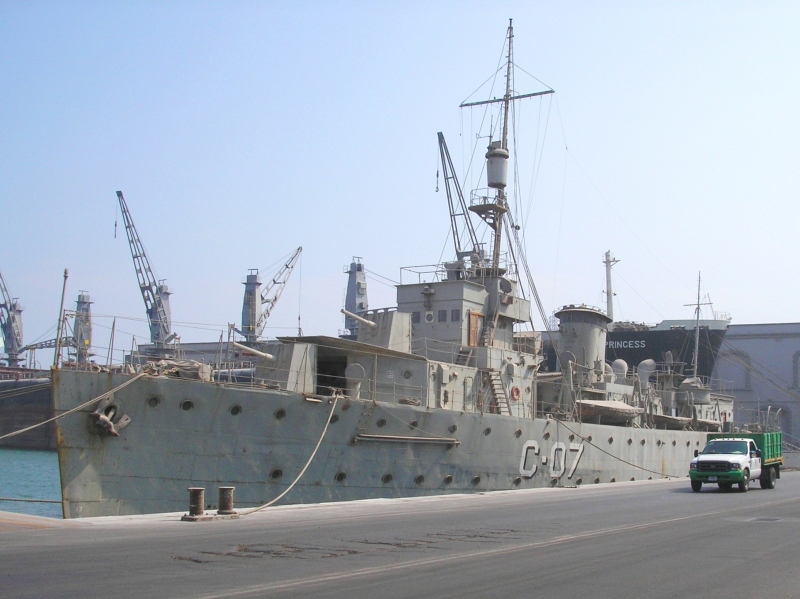
The gunboat Guanajuato after the war (src shipspotting.com)
Mexico position towards the United States was unclear and the country remained neutral. However, Nazi propagandist Arthur Dietrich and his agents in Mexico successfully manipulated editorials covering the European war via bribings, leading major oil companies to boycot Mexican oil following Lázaro Cárdenas’ nationalization of the domestic oil industry, and expropriation of all oil properties in 1938. Mexico’s started to sell its oil to Germany and Italy as a result.
Manuel Ávila Camacho, Cárdenas’s successor, moved away from nationalistic autarchy and proposed to create a better climate for international investment. This move was started decades before under Madero. The new president’s regime regime froze wages, repressed strikes, and instituted the “crime of social dissolution” to lower dissidence. The PRI shifted away from radical nationalism under Cárdena. The country played a relatively minor role in World War Two. Relations warmed already under U.S. President Franklin Delano Roosevelt with the “Good Neighbor Policy” toward Latin America, and Mexico aligned with the United States in 1940, but under a “belligerent neutrality” prior to the Pearl Harbor attack in December 1941.
Mexico went as far as sacnctioning businesses identified by U.S. intelligence as suppoting the Axis and in August 1941 already, Mexico broke off economic relations with Germany. This was followed by staged massive rallies in support of the government and after December 1941, Mexico took a war footing.
Its biggest contributions was to transport war materiel and labor (Bracero Program) and many Mexican were found in European and Pacific theaters transport fleets. The first trained in Los Angeles in 1942. The Good Neighbor Policy was confirmed by the Douglas-Weichers Agreement in June 1941 securing Mexican oil exclusive for the US, and a generous Settlement in November 1941. This political move led other Latin American countries to be more lenient on their support the Allies.
Naval losses were few: Two tankers in the Gulf of Mexico under Mexican flag, the Potrero del Llano and Faja de Oro, sunk by U-564 and U-106 respectively. This was enough for the Mexican to declare war on all Axis powers on May 30, 1942. however the Navy’s duty was mainly escorting ships in the gulf of mexico and traditional patrols on the west and east coast.
The Escuadrón 201 Aztec Eagles was perhaps the best known contribution of the Mexicans, 300 volunteers trained in the United States as pilots and deployed in the pacific. The Escuadrón 201 fought during the liberation of the Philippines as part of the Fifth Air Force in 1945. In addition the Bracero Program sent 290,000 Mexicans to work temporarily on American farms, especially in Texas.
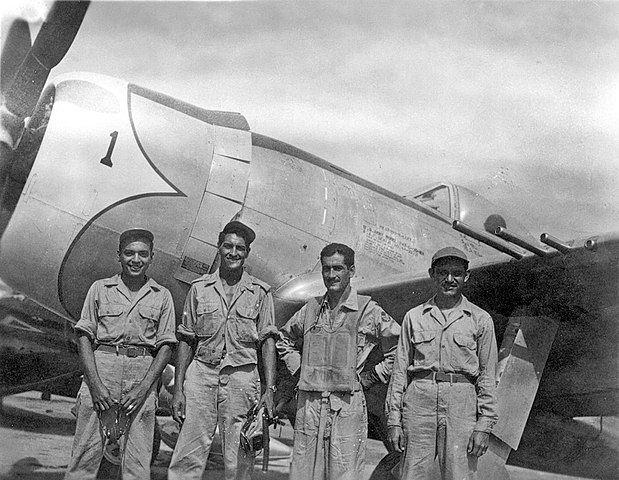
Mexican air force Capt. Radames Gaxiola Andrade stands in front of his P-47D with his maintenance team after he returned from a combat mission. Captain Andrade was assigned to the Mexican air force’s Escuadrón 201. Members of the Escuadrón 201 fought alongside U.S. forces during World War II.(Courtesy photo)
-The Mexican Marines, or “Naval Infantry Corps”, Cuerpo de Infantería de Marina was founded as far as 1922, during the independence war, and the Secretariat of the Admiralty headed by Don Agustín de Iturbide, assigned the first units of the Mexican Army, consisting of four battalions. Two of them were classified as “Marina” stationed in San Blas and Veracruz.
-The Mexican Naval Aviation was created in 1919. A Mexican-made float biplane was successfully tested by Carlos Santa Ana at the Port of Veracruz that year. In 1926, a squadron of floatplanes designed and made for the Mexican Navy was created and Carlos Castillo Breton, became the first Naval pilot in 1927, training in The U.S. and Mexico. Until 1943, some aircraft were acquired with seven naval officers qualified as pilots, some joining the Mexican Air Force. The Naval Aviation school was created in 1943 at Las Bajadas, Veracruz. They used ex-FAM aircraft to patrol the Gulf of Mexico in search for German submarines and training in 1945.
The navy as considerably augmented after WW2 with transfers from the US Navy, notably Tacoma class frigates and APD class fast personnel transports.
Ships in service in WW2:
Gunboat Progreso (1907)
A 1590 tonnes vessel built in Italy at Odero, Sestri Ponente NyD. This went back to odd circumstances: The Italian Progreso in February 1915 was blown-up accidentally while lying in the port of the same name in Yucatan. Ten were killed, as this two-masted, on funneled vessel was sent to support the forced of General Carranza, then legitimate president. She was raised by the Mexicans, repaired, and returned to service, and discarded in 1947.
Specs:
-1590 tons, 70.1 x 10.3 x 3 m
-1 shaft VTE 1400 shp 13 knots, coal 209 tons
-Armed with 4 -6pdr (57 mm), crew 140
Guanajuato class patrol sloops (1934)
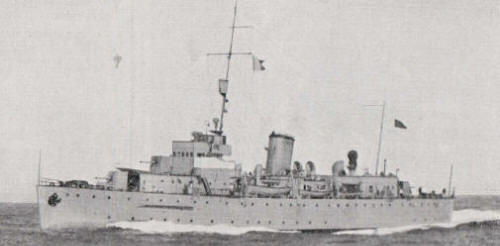
Ordered in Spain in 1932, built at the Societa Espanol in Ferrol, entered service in 1935. First Mexican warships with Turbines, they were as fast as destroyers, but with light guns and no TTs, but a substantial anti-aircraft battery. The class comprised three ships: Guanajuato, Queretaro and Potosi. Design was based on the Canovas del Castillo gunboat. By lowering armament, space was available to take onboard 230 infantry and 40 horses in special accommodation in the aft superstructure. During WW2, all three were modernized in US shipyards in California. They served until 1975.
Specs:
-1300 tons, 77.92 x 10.51 x 3.05 m
-2 shaft Parsons geared turbines 5000 shp 29 knots
-Armed with 3x 4-in (102 mm), 2x2x 25 mm AA, 2x2x 13 mm AA.
-Crew 140
Durango class transport gunboats (1934)
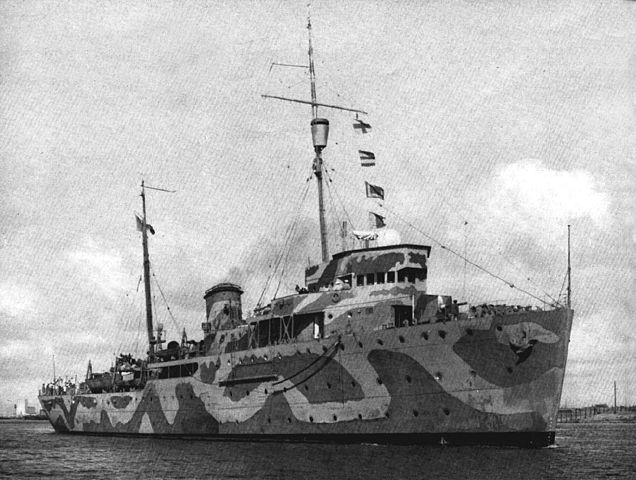
Durango circa 1942
Ordered in Spain in 1932 to replace the transport cruiser Vicente Guerrero. They could carry 490 troops and 80 horses, and horse-drawn field artillery. Durango was built at Levante Yard of Vaencia and Zacatecas at the Echevarria & Larrinaga NyD in Cadiz. As political tensions rose, Zacatecas was seized by the Republican Government and served during the civil war. Mexico never received the latter while Durango was active until the late 1970s.
Specs:
-1600 tons, 85.95 x 12.19 x 3.05 m
-2 shaft Parsons geared turbines, Yarrow boilers, 6500 shp 20 knots
-Armed with 2x 4-in (102 mm), 2x2x 25 mm AA, 2x2x 13 mm AA.
-Crew 141
G class gunboats (1934)
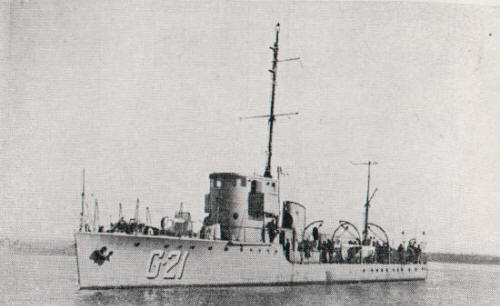
These small coastal vessels were the most important class resulting of the 1932 naval program. They were numbered G20 to G29, built in Basque country at Euskalduna NyD in Bilbao on a British design, with German powerplants and French guns. A truly European affair. This class was split between flotillas of the Pacific ocean and Caribbean. They served until the 1950-60s. The first was discarded in 1945, others in 1954 and the remainder in 1963, modernized.
Specs:
-130 St./180 tons FL, 44.96 wl, 46.63 oa x 5.03 x 1.59 m
-2 shaft MAN diesels, 3000 shp 26 knots
-Armed with 2x 25 mm AA, 4x 13 mm AA
-Crew 21
Coming soon: The Navy of Morroco
Sources/Read more
http://www.fr.naval-encyclopedia.com/2e-guerre-mondiale/marines-3e-rang-2e-guerre-mondiale.php
https://laststandonzombieisland.com/2016/11/16/warship-wednesday-nov-16-estonias-national-hero-aka-the-soviets-immortal-submarine/
https://www.klueser.de/navies.php?pic=nopic&language=en
https://forum.axishistory.com/viewtopic.php?t=5367
https://en.wikipedia.org/wiki/Royal_Hungarian_Army
https://en.wikipedia.org/wiki/Austro-Hungarian_Navy
https://en.wikipedia.org/wiki/Nazi_rule_over_the_Danube_River

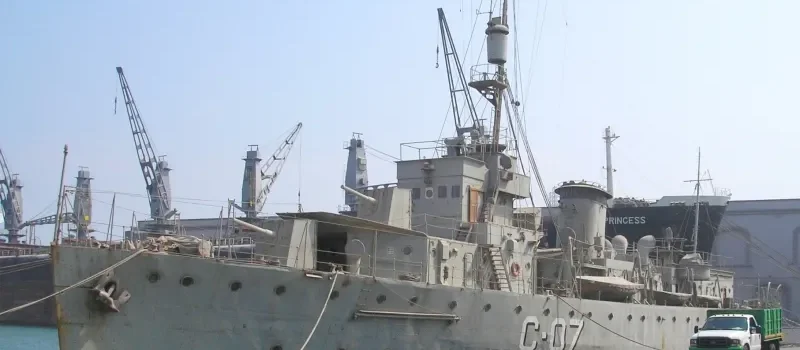
 Latest Facebook Entry -
Latest Facebook Entry -  X(Tweeter) Naval Encyclopedia's deck archive
X(Tweeter) Naval Encyclopedia's deck archive Instagram (@navalencyc)
Instagram (@navalencyc)





 French Navy
French Navy Royal Navy
Royal Navy Russian Navy
Russian Navy Armada Espanola
Armada Espanola Austrian Navy
Austrian Navy K.u.K. Kriegsmarine
K.u.K. Kriegsmarine Dansk Marine
Dansk Marine Nautiko Hellenon
Nautiko Hellenon Koninklije Marine 1870
Koninklije Marine 1870 Marinha do Brasil
Marinha do Brasil Osmanlı Donanması
Osmanlı Donanması Marina Do Peru
Marina Do Peru Marinha do Portugal
Marinha do Portugal Regia Marina 1870
Regia Marina 1870 Nihhon Kaigun 1870
Nihhon Kaigun 1870 Preußische Marine 1870
Preußische Marine 1870 Russkiy Flot 1870
Russkiy Flot 1870 Svenska marinen
Svenska marinen Søværnet
Søværnet Union Navy
Union Navy Confederate Navy
Confederate Navy Armada de Argentina
Armada de Argentina Imperial Chinese Navy
Imperial Chinese Navy Marinha do Portugal
Marinha do Portugal Mexico
Mexico Kaiserliche Marine
Kaiserliche Marine 1898 US Navy
1898 US Navy Sovietskiy Flot
Sovietskiy Flot Royal Canadian Navy
Royal Canadian Navy Royal Australian Navy
Royal Australian Navy RNZN Fleet
RNZN Fleet Chinese Navy 1937
Chinese Navy 1937 Kriegsmarine
Kriegsmarine Chilean Navy
Chilean Navy Danish Navy
Danish Navy Finnish Navy
Finnish Navy Hellenic Navy
Hellenic Navy Polish Navy
Polish Navy Romanian Navy
Romanian Navy Turkish Navy
Turkish Navy Royal Yugoslav Navy
Royal Yugoslav Navy Royal Thai Navy
Royal Thai Navy Minor Navies
Minor Navies Albania
Albania Austria
Austria Belgium
Belgium Columbia
Columbia Costa Rica
Costa Rica Cuba
Cuba Czechoslovakia
Czechoslovakia Dominican Republic
Dominican Republic Haiti
Haiti Hungary
Hungary Honduras
Honduras Estonia
Estonia Iceland
Iceland Eire
Eire Equador
Equador Iran
Iran Iraq
Iraq Latvia
Latvia Liberia
Liberia Lithuania
Lithuania Mandchukuo
Mandchukuo Morocco
Morocco Nicaragua
Nicaragua Persia
Persia San Salvador
San Salvador Sarawak
Sarawak Uruguay
Uruguay Venezuela
Venezuela Zanzibar
Zanzibar Warsaw Pact Navies
Warsaw Pact Navies Bulgaria
Bulgaria Hungary
Hungary

 Bundesmarine
Bundesmarine Dutch Navy
Dutch Navy Hellenic Navy
Hellenic Navy Marina Militare
Marina Militare Yugoslav Navy
Yugoslav Navy Chinese Navy
Chinese Navy Indian Navy
Indian Navy Indonesian Navy
Indonesian Navy JMSDF
JMSDF North Korean Navy
North Korean Navy Pakistani Navy
Pakistani Navy Philippines Navy
Philippines Navy ROKN
ROKN Rep. of Singapore Navy
Rep. of Singapore Navy Taiwanese Navy
Taiwanese Navy IDF Navy
IDF Navy Saudi Navy
Saudi Navy Royal New Zealand Navy
Royal New Zealand Navy Egyptian Navy
Egyptian Navy South African Navy
South African Navy






























 Ukrainian Navy
Ukrainian Navy dbodesign
dbodesign